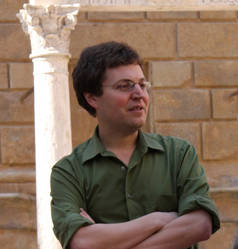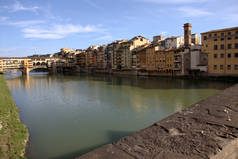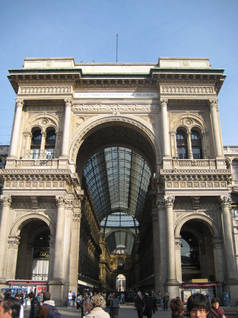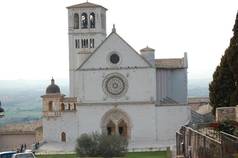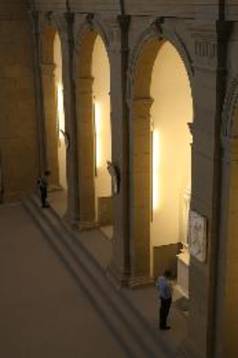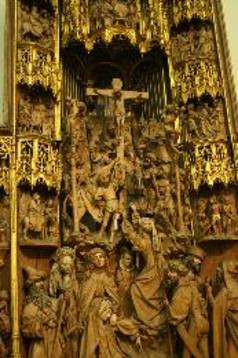
NEWS 2009

Guest Lecture: James McAllister On Beauty in the Sciences
November 15, 2009
David Duncan (PY '10, USA)
On Thursday, November 5th, James W. McAllister, associate professor in Philosophy at the University of Leiden and author of Beauty & Revolution in Science, gave a spirited lecture on the unusual topic of the relationship between beauty and truth in science. Dr. McAllister's lecture tied into the core course for PY students on Objectivity. In addition to the assembled project year students and instructor Bruno Macaes, Co-Dean Peter Hajnal and faculty member Catherine Toal were also present.
Dr. McAllister sketched out a brief but elegant argument with the provocative starting point: "Is beauty a sign of truth in science?" Dr. McAllister quickly moved to define his terms, dividing the consideration of beauty in science into two broad categories; projectivism and objectivism. As the names suggest, the objectivist position maintains that beauty is an objective and measurable property of theories, while the projectivist position suggests that the aesthetic value of a theory is the result of projection onto theories by the relevant scientific community that considers them. McAllister took a projectivist position, defining beauty as in motion and evolving over time. Radical, paradigm shifting theories are usually regarded as ugly, and as they build a track-record of empirical success, they begin to be perceived as more beautiful.
On Dr. McAllister's account, the most pressing issue from the perspective of utility concerns the question: "Is beauty linked to the truth, validity, adequacy, or effectiveness of theories?" His answer was that an a priori link seems unlikely because, empirically and historically speaking; there is an incredible diversity of responses. Furthermore, it is not really possible to substantiate the claim that there is something distinct from, but necessarily linked with, truth. Instead, his hypothesis was one of aesthetic induction, where aesthetic preferences evolve in response to empirical performance. Therefore, the relationship between beauty and truth in science is established inductively in an a posteriori manner and is "perfectly reliable" for as long as the present scientific paradigm happens to endure.
During the presentation, students and faculty were able to ask questions of Dr. McAllister. Some questions were merely requests for clarification while others represented serious challenges to his hypothesis. McAllister also participated in the seminar that followed the presentation and defended his position further, particularly against the suggestion that the definition of beauty as applied to science is so distinct from how beauty is conventionally defined in the humanities that it is not meaningful to use the same word for both concepts. The discussion went on for approximately two hours and was intellectually intense but amiable throughout. As 4:45 rolled around all too quickly and class was adjourned, Bruno thanked Professor McAllister for his presentation and thoughtful participation in ECLA's classroom methodology.
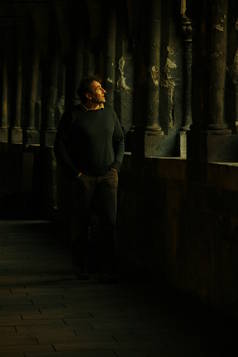
Behind spiritual values: Cathedral tour during Harz trip
November 7, 2009
María Cruz (AY '10, Argentina)
As part of ECLA's trip to the Harz Mountains students and faculty visited two medieval cathedrals, one at the beginning and one at the end of the trip. They were both built in the same period, and both were in the gothic architectural style. Yet each had particular details which made it unique and which connected it to the history of its home city.
It is possible to identify at quite a distance a cathedral built during the gothic period. The first thing that jumps to the visitors' eyes is the amazing height to which such a building reaches. The sharp towers seem to attempt to scratch the furthest clouds. These pointed structures recur throughout the structure of the building, both inside and outside. On entering the building, one can't but feel small facing such architectural magnitude. Large windows cut through the wall every few metres, close to the ceiling of the church. Geoff Lehman, the ECLA faculty member who guided the tour through these medieval buildings, pointed out that the large high-window style was enabled by new technical discoveries and were designed to convey a spiritual message: "having such large windows, so close to one another, is possible because the building is supported not only from the inside, but also with buttresses on the walls outside. Before this, they needed very strong walls and couldn't structurally afford the delicate window features; otherwise the roof would have fallen in". The light flooding through these huge openings also had a very strong meaning, intended to represent the light sent by God to the world. The impressive height of the buildings is intended not only as symbol of divine greatness, but as a clear attempt to build a monument reaching toward the heavens.
The first Cathedral we visited was Magdeburg Cathedral, dedicated to St. Maurice and St. Catherine. Otto the Great commissioned this magnificent work in 955. Due to the devastating city fire of 1207, the Cathedral had to be rebuilt, a process that started in 1209 and took 300 years. The completion wasn't achieved until 1520, and it was with this rebuilding - commissioned by the Archbishop Albrecht II von Kefernburg - that the Cathedral gained its impressive dimensions. Only a wall remains of the original building. Motifs from the natural world are a dominant iconic presence throughout its extent. At the very entrance, the doorknob has the shape of a bird, that, when turned to open the door, leans forward to feed three young pigeons. Most of the intersections of pillars and roof are decorated with ornate leaf patterns that also appear in branches several times across the wall sculptures. Furthermore, the traditional gothic ribs that cross the ceiling bear different nature-inspired figures in the intersections: flowers and wolves, among others. The inside pillars merge into the ceiling with an organic shape, resembling trees. The whole environment leaves the visitor with a peaceful feeling, a very strong idea that the spiritual search and religious life are deeply rooted in nature, man's most basic habitat.
The Cathedral of Halberstadt, the second one we visited, is dedicated to St. Stephan and St. Sixtus, and was built from 1236 to 1486. The Diocese of Halberstadt, one of the most important of the empire, lasted from 804 until 1648. It is world famous for its treasury: more than 600 works of art from the Middle Ages are still preserved there today. The impressive collection consists of altarpieces, sculptures, manuscripts, furniture, works of bronze and gold, which have been on display in the Halberstadt Cathedral since April 2008.The architecture of this Cathedral is a distinctive example of French Gothic, unlike Magdeburg's, which appeared more solid and had an austere simplicity. Halberstadt Cathedral is in a certain sense more refined in this way. It also has a very different iconography. Inside, the large windows of the building, unlike Magdeburg's, serve a didactic function: they are crowded with colorful representations of some of the Bible's most famous passages. The building itself is much smaller when compared with the Cathedral at Magdeburg, although it too reaches staggering heights. The arcs on the ceiling at Haberstadt were intersected with different coats of arms, probably those belonging to the most important families of the city.
Overall, it was certainly enlightening to visit both Cathedrals and to gain insight into the specific styles of each monument by means of comparison. Even though they were built around the same period, and both are unambiguous examples of the French Gothic architectural style, it suddenly becomes very clear how very different effects can emerge within the same style of devotional aesthetic.
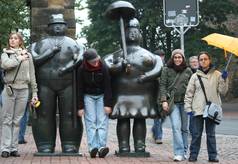
Trip to the Mines of Rammelsberg
November 1, 2009
David Duncan (PY '10, USA)
During the weekend excursion to the Harz Mountains, a group of ECLA students led by faculty member Dirk Deichfuss visited the Mines of Rammelsberg nestled in the town of Goslar. The mines are impressive both from a technical and historical perspective, having been in continuous operation for over a thousand years, and reaching a depth of 400 meters. The mines of Rammelsberg are now recognized as a UNESCO World Heritage Site.
Students were greeted by a tour guide with the traditional miners greeting "Glückauf!" wishing us a safe descent into and return from the mine. We were then directed to the old changing area where hardhats were distributed. Before embarking on our descent into the mines themselves our guide gave a brief description of the ore distribution of the Rammelsberg site. As she explained, the mines are particularly unusual for two reasons. Firstly, because of the high percentage of valuable minerals: up to thirty percent silver, copper, zinc, lead and other metals per load of excavated material. Secondly, because of the distribution of deposits discovered in a grid-like shape for hundreds of meters down, rather than in the vein structure found in most mines. The wealth of silver deposits, initially accessible from the surface, was what led The Holy Roman Emperor Henry I to officially found Goslar as a Free Imperial City. The two rare features, deep deposits and high purity, are what allowed the Rammelsberg mines to be economically viable for over a millennium. Also of interest was a scale model of one of the water-powered wooden wheels used to draw the ore up from the depths of the mine from medieval times through to the beginning of the 20th century.
The group then walked partway up a hill to the doors of the mine entrance, which for all of its history was unassuming but very sturdy. We went through a long underground corridor that at times was less than two meters high. Although this forced a few of the taller members of the group to stoop on occasion, for the most part the mine was surprisingly spacious, with wide corridors and large open areas. In one such area, we saw a full-size, fully functional waterwheel, the size of which was all the more impressive because it had been brought into the mine piece by piece and re-assembled by the pale light of gas lamps!
As we descended deeper into the mine, the group viewed two more waterwheels and a large space where one of the previous wheels had historically stood. Along the way we viewed an underground mock-up that demonstrated how the laying of fire was used by engineers to mine ore in a delicate process that required the evacuation of the mines and precise control of airflow entering the mine.
As we travelled up approximately 40 meters of narrow metal steps to exit the mine, we were able to see the ladders, originally wooden and then later iron, that miners had to make use of when leaving work up until the 20th century. As miners would often be hundreds of meters down, travelling up the ladders could take more than an hour and on average there were one or two deaths each year from falling. This fact must be reckoned alongside the knowledge that, during most of its history, the mines never had more than about two hundred workers.
While everyone enjoyed the tour, by the time we emerged from the darkness of the mine there was a sense relief at being aboveground again. We thanked our tour guide and walked back to the youth hostel, much more appreciative of the engineering expertise and physical determination that had built the Mines of Rammelsberg and the town of Goslar.
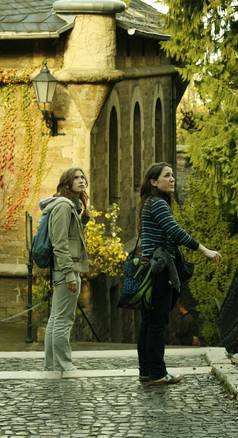
Walk to Brocken Mountain
October 23, 2009
María Cruz (AY '10, Argentina)
After three weeks of intensive academic activities, most of the ECLA community embarked on a three-day excursion to the Harz region that began early on Friday, October 23. First stop was Magdeburg, a small city by the Elbe River with quite a number of interesting examples of medieval architecture, as well as more modern buildings. Here faculty and students visited the Magdeburg Cathedral, an impressive gothic structure that dates back to 955 AD.
By the afternoon, the group reached the historic city of Goslar - our final destination. The first activities involved exploring the picturesque town centre, which looked as though it had stepped out of a history book. The settlement at Goslar was founded in 922 and only a hundred years later became an Imperial City, one of the most important of the Holy Roman Empire. Famous for the Rammelsberg Ore Mine, both this and Goslar's Old Town were declared World Cultural Heritage Sites by UNESCO in 1992.
One of the most thrilling experiences took place on Saturday when faculty and students set out to Brocken, a mountain 1142 meters high and the highest peak of the Harz region. The long hike took around six hours to the top and back. Since the weather was warm and sunny, the undertaking on the whole was both fun and challenging. At the beginning, there was only a path through the thick forest, a great view that every now and then offered wooden bridges over streams and landings to rest from long hours of walking. The path turned out to be more and more difficult as we climbed towards the peak since about half the way up we encountered snow. People of all ages and diverse origins were taking the same tour, giving the experience a truly communal feeling.
Closer to the top, the path ran alongside railway tracks and every fifteen minutes or so a black and red fairytale train with steam popping out of its chimney would make its way past. The Brockenbahn, built in 1899, is one of the three metre gauge railways that run across the Harz National Park. It is certainly a big attraction for those who want to know the Harz region but aren't tempted by the long hours of walking.
Brockenbahnof, the highest narrow railway station in Germany, served as a military base for border surveillance during the Cold War. Until the Berlin Wall fell, the mountain was off limits to all but the Soviet army. For both local inhabitants and visitors alike, the opportunity to hike through the park signifies a celebration of complete freedom.
Once on ground zero again, the ECLA troupe gathered in a warm place to share views on the experience while sipping hot chocolate.

The Installation Exhibition: A sonic experience
October 21, 2009
María Cruz (AY '10, Argentina)
Screaming babies, dark hallways, heartbeats, water, broken TVs, shouts and singers. The first exhibition for the installation module that took place on Wednesday October 21 filled the air with a medley of different sounds that moved the visitors emotionally through the provocation of contrasting moods.
The tour consisted of eight different studios, each presenting a different environment created by a single student. The aim was to express a particular idea or feeling in an artistic way through sound engineering. With the help of lights, cloth, strings, newspapers and other materials, the students were able to submerge the guests in an alternate experience. Picture going through a door to a dimly lit room, covered with torn black fabric, and containing a human size black bag, and filled with sounds of screaming, shots, running, breathing, a shot, and then silence. Another room demanded that visitors concentrate on an ancient book while hearing the sounds of a baby crying, a toilet flushing, and voices carrying through what appeared to be very thin walls.
The exhibition had been announced at the beginning of the week to eager students and faculty who were already anticipating the event: it takes place every year as part of one of ECLA's most popular elective courses. Wednesday's was only the first of the four installation showings to occur this term, which means the best may well be yet to come. Future installations will focus on light, video, and the final work is expected to combine all three.
Former installation students who have had the opportunity to be involved in previous years at ECLA have stated that going through this process is a unique experience. Since the raw material comes from the students themselves, working with it to create an installation often entails a process of self-discovery which involves seeking to meet the challenge of communicating one's ideas to others. In the module tutor David Levine's own words: "it's about discovering and using your own language to express something that is important to you".
The showings, that took place from 7.30 pm to 8.30 pm, certainly triggered a great deal of nervous excitement in each of the eight students. Their work was to be exposed to the assessment of their peers. Now that this first experience has passed by, the artistically-driven students of the ECLA installation module have some exciting projects ahead. We look forward to the next exhibition, scheduled to take place in week 5.

- Marble portrait bust of Homer at The British Museum
Poetry Night
October 2, 2009
Diana Martin (AY '10, Romania)
Continuing the Berlin Weekend programme, on Friday night we gathered at ECLA faculty member David Hayes' apartment to share our favourite poems both in translation and in the original. Sitting on chairs or on the floor, we let our poems flow in circles, immersing ourselves in the mysteries of language.
The night was opened by Robyn Mayer, who recited Hendrik Marsman's poem Herinnering aan Holland / Memory of Holland. The poem represents an emotional description of Robyn's country, a "limitless low-lying land where the sky hangs low and in grey vapours of colour, the sun is slowly blurred".
The poem chosen by Luzie Meyer, Hälfte des Lebens / Half of Life by Friedrich Hölderlin, was a celebration of exuberance and spectacular beauty, while Anna Csak introduced us to the despair and lack of hope of Attila J zsef, a poet less known outside Hungary. The poem chosen by Anna is entitled Születésnapomra / For My Birthday and offers a bitter take on Attila J zsef's troubled life. "Gimcrack knickknack [...] The thirty two are gone, and heck, I've never earned a monthly check".
Luisa Tolu decided to present Antoine Cassar, a Maltese poet who explores the way in which words from various languages can be combined in order to create powerful and exotic sounding poems with a fluid rhythm. His background as a translator allows Antoine Cassar to write his mosaic-like poems not only in his mother tongue, but also in English, Spanish, Italian and French. Luisa revealed his special style with the poem Nota Bene: "The skies are cold and bleak, passo appresso passo mi pento e mi rinvio, nuit d'orage, cri sauvage".
Dialog interior / Interior Dialogue, the poem that I recited, invokes "the grand silence that is necessary in order for any dialogue with one's own self to become possible". It is a poem full of plastic images and mystery, born from the imagination of the surrealist painter Victor Brauner.
The readings closed with the lines of Mark Halliday, as David Hayes recited the poem The Boiling Water. All of us gathered there could identify with Halliday's words in respect to the year at ECLA about to begin: "Serious for us that we met..."
At the beginning of every academic year, and also during the summer school, students and faculty gather to learn more about the special features of each other's cultures, ranging from literature to gastronomy. This ability to create a place where we can inspire one another through shared exploration of our various backgrounds is one of ECLA's cherished traits.
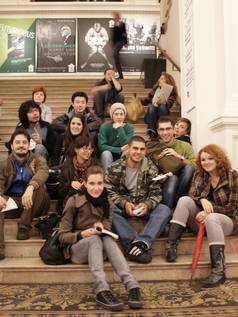
Visit to Martin-Gropius-Bau. "Bauhaus. A conceptual Model"
October 2, 2009
María Cruz (AY '10, Argentina)
In spite of the fact that it was first developed ninety years ago, and that the art school only existed for fourteen years, Bauhaus never gets old. There is always something new to discuss about one of the greatest schools of modernity. As part of the Berlin Weekend program, on Friday October 2, a group of students from the European College of Liberal Arts visited the Martin Gropius Bau on the occasion of the exhibition "Bauhaus. A Conceptual Model."
The exhibition was laid out in eighteen different galleries, organized in chronological order, each one of them representing a different period in the history of the Walter Gropius School of Design and Architecture. The first stage of the tour frames the birth of Bauhaus, giving information on the social situation that obtained in the early 1900s. At the end of this stage there was a video of Gropius himself explaining how he changed his conception of art in order to respond to the social changes occurring at that time.
Unlike other exhibitions on Bauhaus, which have tended to focus on one particular period of the school, this one was structured in order to provide a clear view of the engagement with modernity that the school undertook. The exhibition proceeds all the way through galleries such as "Art-inspired impulses", "The Bauhaus Masters", "The Student's Free Art", "Elementary and Constructive", "The teaching of Kandinsky, Klee and Moholly-Nagy", to "De Stijl and Constructivism" and "The 1923 Exhibition", to name just a few. The visitors could then see the most important issues that the architecture school dealt with. As stated by the organizers: "The exhibition Bauhaus. A Conceptual Model centers on the comprehensive significance of the Bauhaus for the development and internationalization of modernity and goes beyond, examining its world-wide, lasting impact on architecture and design up until the present day". The relevance of the exhibition extends well beyond the Bauhaus movement itself, displaying the enduring influence of Bauhaus throughout subsequent decades.
Bauhaus is commonly known for its workshops, the art-studio class format, and also for its concise and practical view of design. But the exhibition didn't only show the most popular aspects of Bauhaus. The last galleries were dedicated to lesser known themes such as "The Organization of Life Processes"; "People's Necessities, not Luxuries"; "Photography at the Bauhaus" and "Intentional Time Captured in Space".
While all these galleries were around the hall, the center bore two very intriguing pieces. One of them was the Installation "Do-it-yourself-Bauhaus", by the American artist Christine Hill, which focused on the trivialization of Bauhaus in today's consumer and every-day culture. The other piece was a video installation by Ilka and Andreas Ruby, "Endless Bauhaus", where ten interviewees expressed their opinion about the meaning of Bauhaus ideas today.
Designed by the scenographers Chezweitz & Roseapple, "Bauhaus. A conceptual model" was presented in collaboration with the Museum of Modern Art in New York. This exhibition, with well over 900 pieces, constitutes the largest Bauhaus exhibition in history. From the viewpoint of a liberal arts student, it was very enriching to appreciate - in an holistic way - this major contribution to the history of art and design.
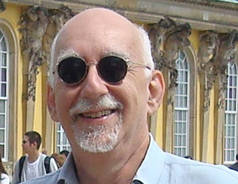
ISU 2009 GUEST LECTURE: Ira Katznelson on Toleration
August 3, 2009
Nora Georgieva (ISU 2009, Bulgaria)
"However flawed toleration may be, a decent human life would not be possible without it. And it is most needed in situations when it's difficult to achieve," Dr. Ira Katznelson said during his lecture at ECLA on July 27.
Author of many books and publications, former president of the American Political Science Association and of the Social Science History Association, Dr. Katznelson is currently a professor within the History and Political Science Departments at Columbia University, where he has taught for the past 15 years. At ECLA he gave an engaging and structured presentation on the topic "What is Toleration? Reflections on the Civil Membership and the Western Liberal Tradition." The definition of toleration offered by Dr. Katznelson for the purpose of his lecture was "an act of reflective and deliberate not-doing against those you dislike even if you posses the means to do so." We appreciated his comprehensive approach to the topic, as he drew a link between several of the texts we read in the past three weeks, toleration and cruelty, the topic of focus during Week 4.
His main contention was that toleration and liberalism enhance one another, but that it is too dogmatic to think this connection is obvious and indisputable. To support his argument, Dr. Katznelson discussed the main principles of liberalism and pointed out difficulties in completely reconciling it with toleration. For example, liberalism supports the rights of the individual, but tolerance emphasizes the need to set boundaries which may limit certain rights.
This was Dr. Katznelson's first visit to ECLA. "I'm quite interested in the nature of liberal arts education generally and therefore the kind of experiment ECLA represents, a small, intensive, multinational education focused on questions of values and reading great texts. [I think] this is a successful format of education," he said.
Liberal arts education plays a role in promoting toleration but it's not sufficient, Dr. Katznelson said. While this type of education enhances appreciation for human diversity and forces us to think hard about our assumptions, it alone gives no guarantees. At least equally important is the existence of institutional arrangements that give scope to diverse ways of living because one person at a time is not enough to create a setting of toleration. Human history gives examples of people who were educated in the liberal-arts tradition but did not practice toleration. "A good liberal arts education forces individuals out of their zone of comfort and asks them to understand a wide range of experiences, cultures, practices. Hopefully that makes toleration more likely. I think it does," Dr. Katznelson said.
We hope Dr. Katznelson will return to ECLA and were happy to hear that he enjoyed his time with us as well: "I've been treated with warmth, hospitality and intellectual engagement. Even though I've been here a short time, it was extremely interesting to me," he said.
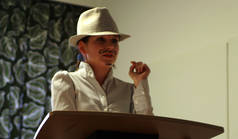
SPEECH NIGHT AT ECLA
July 29, 2009
Nora Georgieva (ISU 2009, Bulgaria)
After almost three weeks of philosophizing in the company of Montaigne, Seneca, Tolstoy, Machiavelli, Shakespeare and other great minds, we were ready to take on another challenge - the Speech Night. A tradition existing for several years already, this year's Speech Night is now officially named after the current Romanian Minister of Culture Theodor Paleologu, who is also a former ECLA faculty member.
This year there were four areas in which the speakers had to give 3-minute speeches after only 10 minutes of preparation time. The areas were politics, religion, culture, and economics and each area had three or four contestants. Two of the faculty members, David Levine and Daniel Andersson, decided to take part in the fun and compete against their students. The jury consisted of the ISU faculty members who announced the winners at the end of the contest and awarded them with a bottle of wine or champagne.
The topic which invited the biggest number of participants was religion. What the four students probably did not expect when they signed up for this are was the topic: "God is a tyrant." However, all four managed to find their way to tackle it. Andrei Decu (Romania) sent out the thoughtful message: "We don't choose our tyrants, they choose us." On the other hand, Samantha Perera (USA) said it does not really matter whether god is a tyrant or not because "nobody pays attention". The two most contrasting opinions were those of Midori Fujita (Japan) and Mykhaylo Kushnir (Ukraine). Midori distinguished between a dogmatic God and a more personal God, concluding: "of course he is [a tyrant]." Mykhaylo, on the other hand, reminded everyone that God created the world with love and improvised a quotation of the Bible: "As God said, 'Follow me and you will be happy.'" For the discourse on religion, the jury was won over by Samantha's nihilism.
The speech topic for politics was just as controversial: "Toleration is just another word for weakness." Here Ali Ozen (Turkey), Ardi Priks (Estonia), and Mariya Ilieva (Bulgaria) went into abstract discussions of what is weakness but in the end they all seemed to agree with Mariya that "Toleration is strength." The jury also agreed and gave her the first prize.
"Culture is waste" was the unambiguous topic for the discussion on culture. Here Moritz Poesch (Germany) and Nora Georgieva (Bulgaria) had to measure their public speaking abilities against their theater professor David Levine's. Initially, David seemed to defend the position stated in the topic, but he argued that culture constantly tries to overcome its condition. His final challenge to the public was: "But is waste such a bad thing?". Nora seemed to head in the same direction as well, but concluded with the modest statement: "Culture is not waste, it's something a little better." Moritz, however, was a strong defender of the idea that all culture is waste, basing his argument on the readings we had so far. Although the jury found his speech very entertaining in its irony, they chose to award Nora with the coveted bottle of wine.
In the sphere of economics, the contestants took on the ancient fight whether rich people are happier than poor ones. The topic was "The rich do what they can and the poor suffer what they must." Diana Constantinescu (Romania) took a creative approach to the topic and appeared as a slightly arrogant and very nonchalant French banker who was sure of one thing: "Virtue was invented by the poor so that they could cope better with suffering". On the other hand, Jona Dundo (Albania) defended the thesis that being rich is not that good: "We all do what we can and we all suffer what we must." The students in this category competed against the faculty member Daniel Andersson, whose speech took a musical twist as he based his argument on a quote by Ginger Spice from the Spice Girls. "It is the rich who suffer and the poor who are truly rich," he concluded. The winner in this category was Jona.
After the awards were handed out, the night took a completely different shape and students and faculty performed music, playing guitar, violin, and piano and singing. This year's Speech Night ended many hours after it started after performances of songs in many different languages and accompanied by many cheers.
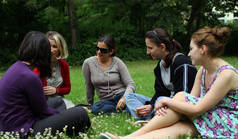
ISU 2009
July 28, 2009
Nora Georgieva (ISU 2009, Bulgaria)
On July 1, students started arriving for this year's ECLA International Summer University (ISU) devoted to "Montaigne and the Making of the Modern Self." The quiet residential neighborhood was awakened by the sound of young people talking excitedly, eager to get to know each other and their new summer home. ISU 2009 began even before the first lecture was held, as the students started discussions on topics ranging from philosophy to the history of their home countries to where in Berlin to go first. This year the 34 students come from 20 countries.
At the end of the first two days, most of the ISU participants ended the day enjoying a drink in the middle of the grass-covered football field between the two residence halls. Several ECLA alumni, Igor Letina (ISU'07, Bosnia and Herzegovina), Snezhina Kovacheva (AY, ISU, Bulgaria) and Daria Coscodan (PY, AY, Moldova) joined the newly arrived and offered advice on the summer university and getting around Berlin. For the ones who stayed out the latest, Daria played several beautiful Portuguese and Moldovan songs.
Part of the first week's activities was devoted to helping the students explore the beautiful city. On the first weekend, students were taken for a walk in the central neighborhood Mitte. The tour was led by art historian Aya Soika, who gave short talks about different historical sites. Ms. Soika led the students through picturesque city Hofs (small squares within the walls of a residential complex), streets with interesting historical stories, and the imposing Museumsinsel (Museum Island). At different times during the first days, students ventured into the various areas of the city on their own, armed with their city guides. Many discovered that getting a little lost in a big city can be quite a challenging and bonding experience.
On July 3, the students officially met the professors at an introductory lecture and a delicious barbeque at which students and faculty broke the ice and informally began their academic dialogue. The introduction was opened by one of ECLA's Co-Deans, Thomas Nørgaard, who encouraged the students to fully enjoy the interdisciplinary approach of ECLA and take the most out of it. Most of the students had not experienced the liberal arts system before. Traditionally for ECLA, the faculty members, just like the students, come from various educational and cultural backgrounds, which makes the exchange of ideas all the more interesting. The ISU 2009 faculty are: Ewa Atanassow (Bulgaria), ECLA faculty; Daniel Andersson (Sweden) who joined ISU this summer; Bartholomew Ryan (Ireland), visiting faculty at ECLA and part of the ISU faculty for the third time, Max Whyte (USA), returning for his second ISU, and the ISU director for the past three years, David Durst (USA).
After the relaxed orientation days, the students focused their attention on their first readings for the following week. This gave the neighborhood the chance to catch its breath and enjoy the silence, but only for a short time. Come back to the ECLA News section in the coming days to find out what happened next.
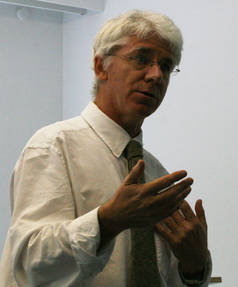
ECLA GUEST TEACHER: Thomas Doherty on Modernity and the Language of Real Life
July 14, 2009
Elena Volkanovska (2009, Macedonia)
On Wednesday, June 3, Professor Thomas Docherty opened a lecture on Karl Marx's ideology by putting forward a provocative question: Are the days of Marxism really over? Or can we still expect a 'revolution'? Although the question was not weighed down by a serious tone, the presentation and discussion explored the ways in which it remains pertinent.
In order to unfold Marx's ideas and arguments, we turned to Hegel -- or, more precisely, to his followers and his critics. Hegel offered perhaps the most influential philosophy of the working of the state, but both Old and Young Hegelians noted one central failing within it: his theory posits an ideal that the real state, in its everyday functioning, cannot live up to. From this problem derives one of Marx's biggest concerns: what do we do with the discrepancy between the abstract concept of the state, expressed in words, and the experience of those who live within the framework it establishes? Marx describes the criticisms posed by the Young Hegelians as the mere juxtaposition of 'phrases' with 'phrases'. There is a stark difference between things as they really are and the way we represent them (the saying of things). He asks why none of his contemporaries investigate the connection between German philosophy and German reality and thereby connect their criticism to their material context.
Marx seems to claim that the only possible way to bring the state closer to its ideal lies not in reformation, but in dissolution. A new set of material circumstances should be created, and from this world new ideas will arise. Man produces himself through labour, and presents a hinge between the past we have inherited and the future that follows. It is interesting that for Marx, changes in ideas come after the world has changed, and not vice versa, as one might think. God is a product of our consciousness, an alienation of something from within ourselves onto the outside world. Man is an event, an irruption, and has the power to act upon history and to change its course. "Event" is meant in the sense that each action does not have a predictable outcome; something is an event only when we do not know what the outcome was to have been. Marx's view of historical possibility parallels his view of language. Rather than dwelling on its capacity for producing distortion and conflict, he emphasizes, like the Romantic poets, "the real language of men", language as communication between human beings, as real, practical consciousness.
Thomas Docherty is Professor of English and Comparative Literature at the University of Warwick. His main fields of interest are the philosophy of literary criticism, critical theory and the cultural history in relation primarily to European philosophy and literature. Some of his books are Reading (Absent) Character; John Donne Undone; On Modern Authority; Postmodernism; After Theory; Alterities: Criticism and Modernity. His latest book is Aesthetic Democracy.
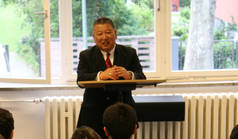
MONGOLIAN EVENING AT ECLA
July 13, 2009
Elena Volkanovska (2009, Macedonia)
Perhaps one of the most fascinating things about ECLA is its international community. ECLA is a place where one meets people from all over the world, where one can embrace many different cultures by having the world in just one room. On Wednesday, May 27, all the members of the ECLA community had the chance to attend a Mongolian Evening, dedicated to the presentation of Mongolian traditions and culture.
Tuvshinzaya Gantulga (AY 2009, Mongolia) opened the evening with a very sincere confession: "If I-a Mongolian-would never talk about my country, never make my culture accessible, how could I expect others to know about my country?" For his speech, Tuvshinzaya prepared answers to the questions most frequently asked by students. This proved to be the right method, mostly because the questions were so honest, a true blend of natural curiosity and a will to learn more. In order to present a clearer picture, he constantly made comparisons which were familiar to everyone, so that we were acquainted not only with the meaning of what he introduced in numbers or words, but we also managed to truly grasp what he was referring to by having it presented in concepts close to our established way of understanding. For example, Mongolia is "four times larger than Germany".
This brief explanation of Mongolia's tradition, culture and history was followed by the introduction of the Mongolian ambassador to Germany, Dr. Galbaatar Tuvdendorj, who addressed the audience and talked in more detail about the turbulent changes in the political organization of the country that took place over the past years, the impact these changes had on society, and the current situation in Mongolia. As far as economy is concerned, Mongolia, like the rest of the countries in the world, is caught up in the financial crisis that has been shaking the world over the past year. What is important is that Mongolia is focused on education and makes sure that its students have the opportunity to study abroad so that later on they can apply their knowledge to better the prospects of their country. Dr. Galbaatar, who, prior to accepting his post as an ambassador in Germany, was the Vice President of the Mongolian Academy of Science, said that he was very pleasantly surprised by ECLA's programme and the focus it has on an understanding of values. He believes that it is exactly this focus that the world lacks, and that only through respecting values can we strive towards the establishment of peace and balance in this world.
After Dr. Galbaatar's speech, we enjoyed some traditional Mongolian dishes -- such as "Buuz" or "Бууз", traditionally eaten at home at the Mongolian New Year. What followed was a live performance by the Mongolian folk band Egshiglen in our lecture hall. At once, past and present were intermingled as the building was filled with the sounds of traditional Mongolian music, which both calmed and excited the spirit. This created a perfect atmosphere, suitable to wrap up this evening into one of the best presents that we could ever get. So, Bayarlalaa (Mongolian for thank you!) to the guests and to everyone who participated in the organization, who made this possible and who took care that we could experience such a palpably authentic event.
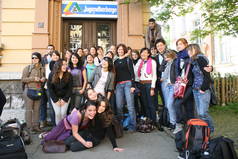
Traditions Must Be Kept
June 10, 2009
Brindusa Birhala (PY09, Romania)
Should anybody ask us how the 1st of May in Berlin was, we could not provide any testimony to it, because ECLA journeyed to Weimar for the whole weekend. One more proof that we here are not street fighters, but passionate lovers...of culture! The bright and early start at 7 a.m. might have seemed extreme to a few, but once cosily arranged in the bus, sleep took over the crew faster than you can say "Autobahn". Unfortunately the regular 'mastermind' of the ECLA annual Weimar trip, German language instructor Dirk Deichfuss could not join us, but his presence was felt in the tip-top organization and in the choice of an 'echte Deutsche Jugendherberge', where we spent the night. To replace him, residential life coordinator Zoltan Helmich filled the necessary role of jack-of-all-trades, which included everything from tour guide to bus paparazzo.
Opening our eyes to Weimar requested several leaps into the past, to the times of Goethe and Schiller, also earlier, to those of Lucas Cranach, and to the more recent Bauhaus School. Very appreciative of its rich cultural heritage, this town knows how to display it to any bunch of curious tourists like us. Posters announced the celebration of 90 years of Bauhaus, several congresses, and the staging of Romeo and Juliet at the German National Theatre. The sound of hoofs on cobblestone announcing carriages, people in XVIII Century costumes, and meandering narrow streets make this little town appear intrusively surreal. Thank God for the popular celebration in the main square to remind us that there are still wursts and politics in Germany. Especially on the 1st of May!
Some of us could not resist the welcoming cafés; others rushed to the huge Park on the Ilm, while the rest hid away from the sunny day within the walls of museums. I admit being in the last category, but it also includes the German art class who spent their free time in the Bauhaus Museum. Schiller's house, The Weimar Town museum, Anna Amalia Library, and the Nietzsche Archive were among the places that lured some of us for short visits. We later reunited to fulfil an important tradition for ECLA: the visit to the Goethe National Museum. This is the house which the poet received from Carl August, grand duke of Saxe-Weimar-Eisenach in 1792, and in which he lived after his return from Italy, for almost 50 years, until his death. The building was opened as a memorial building half a century later.
One can't expect to grasp his genius solely in the many exquisite objects that he collected or received over the years, but the visit is certainly awe-inspiring each time. The museum guide presented the cult-corners of the house such as his library, his study-room and the simple room in which he died, which are accessible to the visitors only from afar. To complement this tour, we headed to Goethe's first abode in Weimar, his Garden House in the park, and paid tribute to another tradition-playing Frisbee together in the lush surroundings. Just as important, I should not forget to mention the wonderful dinner together and the nocturnal walk to the hostel.
Saturday was 'wander-full', as the bus took us outside Weimar and placed us on Goethe's trekking route - the 28-kilometre "Wanderweg" from Weimar to Großkochberg. It's not difficult to imagine the natural landscape along the way inspiring Goethe to produce one of the most famous lyric poems in German literature, the Wanderer's Nightsong. En route we ran into dedicated Goethe "pilgrims" who keep the tradition by walking the entire length through the same meadows and villages that carried the steps of the naturalist through Thuringia. Goethe needed only 4 hours for this trip, but we lingered from one pleasant conversation to another and took plenty of time to admire the scenery, especially at the end of the route, where we climbed up Luisen tower and exchanged smiles with the crowd of summery German wanderers. This part of the Weimar excursion was included for the first time this year; it was such a perfect ending and celebration of Goethe's spirit, effectively fusing us into a community, that it surely made itself eligible to become another ECLA tradition.
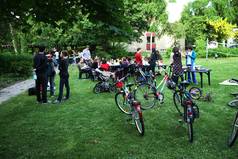
Family Portrait
June 9, 2009
Brindusa Birhala (PY09, Romania)
We use our beautiful campus gardens in a variety of ways: student-professor football, volleyball, or badminton matches, mastering the Frisbee, sunbathing, reading or sleeping in the grass, and even treasure hunting. Elizabeth Hanka (AY, USA) proposed dining there too, and the idea expanded to that of a barbecue in the garden, which warmly welcomed everyone from the present student-body, faculty and administration. One of the skillful people behind the grill was Adrian Nicolae, alumnus of the AY 2005-06 program, currently an MA student in Bonn, who coincidentally was an overnight guest. Without doubt he easily connected with the current class and attracted our interest, mostly since he was the one grilling our potatoes. He admitted to being struck by nostalgia, and to being happy to be back in these gardens.
Elizabeth's idea coincided with her bicycle community project, and afforded an opportunity to finish a process that had been in the works since the first weeks of the school year. Her proposal that students should be supported in buying bicycles to use during the year resulted in people pairing up to buy bicycles at the Mauerpark flea market, for which they were then reimbursed. Everyone had bought their bicycles by the end of the winter term, and it was a relief to have such an easy way to get off campus and explore the city when the spring came. However, the project was not complete, as another part of it, aside from simply having the bikes to share and use, was to make them community bikes by decorating them. After much debate about whether to paint them all, attach some kind of sign to them, or put stickers on them, we finally decided on the sticker method. Each student was presented with a veritable rainbow of stickers, and getting together for the barbecue proved to be a great opportunity to "rebrand" the bicycles we have been using since spring. Brightly coloured ECLA stickers signal now that there's something special about our bikes, something that is worth checking out. Because they are being pedaled throughout the city by students eager to discover it, we expect the stickers to become visit cards in motion.
We were pleased to be able to host faculty members and their families at our barbecue, and be able to converse with them on the grassy background instead of in the usual classroom buildings. I personally enjoyed the company of "little ECLA", the young children of our faculty and staff; they got to know each other, and carried important debates around the ownership of toys. The contributions of various students' personal recipes, experimentations and collaborations, combined with dishes generously brought by faculty members, made for a diverse and delicious feast. The party was also encouraged by the expertise of some of our more technically minded students who spontaneously hooked up a sound system to which we took turns attaching our laptops to for a variety of music. After a full and satisfying day, things wound down into the night as small groups stayed on the lawn reflecting on the experience of being here together before drifting off to bed.
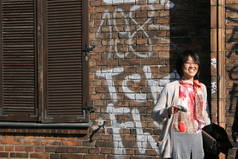
Whose Is That Wall?
June 04, 2009
Brindusa Birhala (PY09, Romania)
The very first event of State of the World Week materialized with the support of ECLA art history faculty Aya Soika and addressed one of the many features of Berlin that I find particularly fascinating -the ubiquitous street art. I became a discoverer of street art when I saw that familiar cities 'back home' were no longer neutral, but had started to engage each pedestrian with their playfulness. Suddenly, forgotten corners of Bucharest, Brasov or Timisoara blossomed into gems of style and wit through which one 'reads' how a special group of dwellers lovingly approach their cities and poke at the indifference of others. No surprise that once I got the chance to live in Berlin, I felt like a child in a candy store. Walking (or biking) though the streets here comes close to reading a perpetually changing comic book. For this reason, I needed to transmit a dose of my exhilaration to those ECLA classmates with an eye prepared to see art in the most unexpected sites. My proposal for this years' SWWE was a presentation of street art and the question of ownership, followed by a walk through Kreuzberg where we got more acquainted with the 'works' and, indirectly, with the artists.
What we call 'street art' now is an umbrella term which originated in 1960s wall scribbling, and which expanded to include other manifestations that share a fundamental characteristic: using public space as display. Spray-painted names or words on building façades were a nuisance to everybody, initially; regarded as vandalism and punished by state authorities, this set the course for many of the practices still present in street art operations: the anonymity of the artists, the speed at which they work (prompted by the fear of being arrested), the formation of a 'behind-the-scenes' community, and the ephemeral and critical nature of this art. The scope is now international, no longer restricted to an urban setting, and by gaining the appreciation of city dwellers, it gradually grows out of its illegal relation with the city authorities. Nonetheless, this is a slow process undercut by massive arrests and rapid defacing of the works, even in cities where street art is old news by now.
The controversy behind this practice offers various opportunities to ask the question: Who does a wall belong to? One could argue that since the artists remain anonymous and use public space as display, street art should be viewed as an act 'of the people for the people'. Its critical discourse seems to point in the same direction, with works that either illustrate the problems of the neighbourhood community or carry a broader counter-cultural message. The first level of inquiry in my presentation was the legitimacy of using public space as display and an examination of the many functions of street art: as protest, to entertain, to represent, or to embellish the streets. I embrace the interpretation of street art as standing in opposition with consumer society; through its discourse, it exposes the pervasiveness of outdoor advertising that clogs up public space and laments the complacent attitudes of both citizens and authorities towards it.
The growing popularity of the genre sends the works into art galleries (albeit of the 'alternative' variety) and generates international recognition for the artists. As a result of the latter, we now see strange paradoxes such as the auctioning of pieces of street art, or neighbourhood inhabitants raging about 'their' street art being vandalized (covered up or tainted by anti-graffiti groups). Insofar as artists (or groups) develop their recognizable styles and tags, street-art pieces are associated with them, and are thought to belong to them. At the same time, people who encounter them every day develop feelings of attachment and regard their disappearance as a theft from their common property. The artists one tends to associate with Berlin are already consecrated 'travelling acts' like BLU, Banksy, JR and Os Gemenos, whose works are large scale and have been legally produced under the tutelage of street art festivals financed from the city's culture funds. Nonetheless, for me, street art maintains its flavour when it sneaks onto the wall illegally and unexpectedly overnight, like in the repetitive characters of 'local' artists Nomad, CupK, Alias, XOOOOX, or MYMO. Thinking about ownership in relation to street art makes one wonder whether the concept of ownership per se is not outside the scope of this genre.
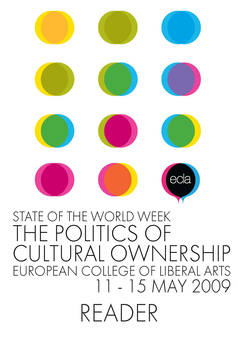
SWWE GUEST LECTURER: Volker Wiese: Seminar on "Legal Issues in the Restitution of Cultural Heritage"
May 24, 2009
Snezhina Kovacheva (2009, Bulgaria)
Monday's theme on restitution was further developed in an afternoon seminar led by Dr. Volker Wiese from Bucerius Law School. The main goal of the seminar was to examine several legal aspects of the restitution of cultural heritage. The discussion centred on the essence, as well as the legal and ethical implications, of the concept lex rei sita, which stipulates that "questions related to the validity of a transfer of personal property are governed by the law of the state where the property is located at the time of the alleged transfer."
Students, faculty and Dr. Wiese explored how the trade and restitution of culturally significant objects is complicated by the diversity of local laws that concern bona fide purchasers - buyers who acquire a cultural item in accordance with local trade laws and are not aware of the special provenance of the item, which belongs to the cultural heritage of a foreign country. While in Germany, bona fide purchasers become lawful owners as long as the object has not been stolen before, Anglo-American laws do not apply the concept of bona fide acquisition of property at all. On the other end of the legal spectrum, under Italian law bona fide purchasers are honoured even when it becomes known that the property had been stolen before from its original owner. The seminar participants discussed how specific historical and cultural developments in each country might have contributed to the formation of a particular legal view on bona fide purchases. To illustrate the practical significance of the fact that the international community does not have a standardized international framework, Dr. Wise presented several insightful cases where local laws are recognized in the case of a sale even if the cultural item has been abducted from a legal order that does not follow the concept of bona fide purchase, and has been subsequently brought back to that country.
The seminar also considered the issue of declaring cultural objects res extra commercium, which makes the objects themselves non-tradable, and the transfer of their ownership legally void. However, the international treatment of such cases is not uniform, Dr. Wiese pointed out. He first presented a case in Italy, where the courts established that the rule shall be strictly confined to the territory of the original state. In effect, this makes it legally permissible for a cultural object declared res extra commercium in Spain, for example, to be traded in the territory of Italy. Dr. Wiese juxtaposed this case with the ruling of a French court, which argued that the legal nature of a foreign res extra commercium cannot be domestically disregarded.
The seminar scrutinized the soundness of legal rules when applied to the special intellectual context of cultural items, and considered whether and to what extent legal rules can and should reflect intricate ethical judgment and embody changing moral codes. A wide variety of relevant questions were discussed, including whether the law should foster trade with cultural items or embody policies that tie the objects more strongly to their country of origin, and what the implications are for cultural exchange and the preservation of cultural heritage.
Volker Wiese teaches at Bucerius Law School in Hamburg and specializes in restitution policies. He obtained a Master of Laws (LL.M.) from McGill University for his thesis: "A new Approach to the Private International Law of Copyright" and a PhD. from Bucerius Law School in 2005, on "The Influence of European Law on International Property Law pertaining to Cultural Property".
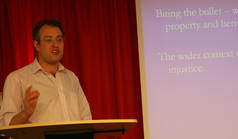
SWWE GUEST LECTURER Daniel Butt: Cultural Property and Cultural Heritage - who owns what, and why? What should museums and collectors give back, and what should they keep?
May 24, 2009
Snezhina Kovacheva (2009, Bulgaria)
May 11 - the first day of ECLA's State of the World Week (SWWE), a forum for inquiry into current affairs - was devoted to the concept of restitution. In the morning, Daniel Butt from Oxford gave a lecture on the theoretical foundation of contemporary claims for compensation and property restitution, which arise as a result of past wrongdoing between nations. Butt framed this discussion within the larger theoretical context of property ownership.
Butt distinguished between two fundamentally different views on distributive justice: forward-looking, primarily concerned with generational redistribution, and backward-looking, which focuses on the historic entitlement to property. Butt explained that proponents of the former principle usually criticize the latter from two distinct perspectives: equality of opportunity and efficiency. Egalitarians disapprove of how the property mechanism helps perpetuate and accentuate a division among people that is arbitrary from a moral point of view. At the same time, consequentialists find it problematic that property rights obstruct the optimal use of resources from a societal perspective (i.e. a particular piece of land may have yielded higher output if maintained by a professional agriculturalist, rather than by its owner).
Butt's goal was not to present in further detail divergent perspectives in the intellectual discourse on property (which ECLA students are approaching as a part of their AY core course on the same topic). After briefly referencing contributions of such major thinkers as John Rawls and Robert Nozick, the lecturer primarily focused on the domain of cultural property, beginning by pointing out an inconsistency among some vocal advocates of a cosmopolitan view on cultural property. According to this group, cultural heritage belongs to humanity as a whole and preservation overrides historic concerns. But while some "redistributive cosmopolitans" object to the possibility and necessity of rectification of historic international injustice in the context of cultural property, they do not support the large scale general redistribution that would seem to be consistent with their own principle and argumentation. Butt emphasized that such a dualistic attitude is inconsistent and thus problematic in a world where "ownership matters."
For a backward-looking theory of distributive justice to work, one needs to ascertain the legitimacy of initial property holding and the justifiability of inheritance, Butt established. He commented on each concept and put forward arguments as to why the acquisition of cultural property might be less problematic than that of land, natural resources and money. He then proceeded by enumerating the major elements behind the theory of correcting historic international injustice through restitution: 1) there has been a victim of injustice and a respective benefactor; 2) collectives exist that have failed to correct past wrongs, and 3) the descendants of the victims have at least moral, if not legal, entitlement to the particular object(s).
Butt explained how attributing property to national collectives is the best response to indeterminacy and diffusion of ownership in the cases when much time has passed since the act of injustice. He also elaborated that the failure to rectify injustice may give rise to due compensation for the period during which a nation has been benefiting from the possession of the cultural property in question. In response to the "noble preservationists," who claim that -but for their intervention - the property might otherwise have been destroyed or not taken care of, Butt replied that preservation may deserve praise and compensation, but does not obliterate prior entitlements to the object or confer absolute property rights to the current keeper.
The lecture called attention to the idea that a policy of cultural-property restitution would not lead to an ominous worldwide reshuffling of museum holdings wreaking havoc among most museums, since much cultural property was produced for trade and acquired fairly. Butt also outlined a practical mechanism for classifying cultural property into four categories: 1) culturally central; 2) culturally peripheral; 3) intrinsically sensitive (when a community does not wish objects to be displayed in public, e.g., human remains), and 4) circumstantially sensitive (when a national collective is especially concerned with the fact that a particular nation, such as a former conqueror or colonial power, possesses an object deemed culturally important).
In his afternoon seminar, Butt used a case-based approach to illustrate the intricacies and ambiguities of real-world restitution. Students and faculty discussed the moral justifications for returning to Greece the Elgin Marbles, a collection of classical marble sculptures, originally a part of the Parthenon in Athens and currently in the British Museum in London. The grounds for restitution were also discussed in the cases of Benin marble sculptures appropriated by the British Empire in 1897; the partial return the Teotihuacan murals to Mexico by USA; the looting of art in Nazi Germany, and the public display of shrunken heads that belong to an ancient tribe, at the Pitt River Museum in Oxford.
Daniel Butt teaches at the Department of Politics and International Relations at the University of Oxford. His primary research focus is on questions of global justice, in particular on normative questions relating to the rectification of historic international injustice. His book Rectifying International Injustice: Principles of Compensation and Restitution Between Nations, excerpts from which were read by ECLA students as preparation for his lecture and seminar, has just been published by Oxford University Press (2009).
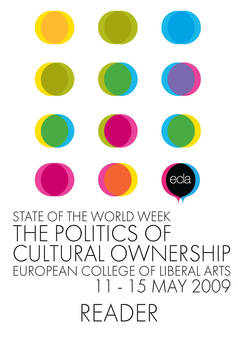
STATE OF THE WORLD WEEK AT ECLA 2009
May 13, 2009
Press Release
Monday, May 11, was the first day of this year's State of the World Week at ECLA (SWWE) dedicated to the theme "The Politics of Cultural Ownership." The week-long series of events (May 11 - 15) constitute a forum for inquiry into current affairs, and is planned by faculty and students together. SWWE fulfils an integral part of ECLA's educational mission by demonstrating the relevance of Liberal Arts studies to contemporary world events.
The issues and questions examined this week include: Who owns artefacts in museums? Who has the right to decide whether an art work should be restored? Who has the authority to speak for a culture threatened by collapse? Can cultural identity itself be an object of ownership? What happens to the notions of copyright and intellectual property in the era of the internet, new media and file-sharing? SWWE presents a platform for leading scholars, artists and other experts - together with faculty and students - to explore what happens when the ownership of art is challenged. The topic raises questions that are strongly linked to the Academy Year core course on the concept of 'Property' in modernity.
Speakers at SWWE include:
DANIEL BUTT, Fellow and Tutor in Politics, Oriel College, Oxford. Writer of Rectifying International Injustice
VOLKER WIESE, teaches at the Bucerius Law School in Hamburg and specialises in restiution policies.
JOY GARNETT, College Art Association's Committee for Intellectual Property, Arts Editor for the scholarly journal Cultural Politics
RUTH FRANKLIN , Senior Editor at The New Republic.
DENISE BUDD, Lecturer-in-Discipline in the Core Curriculum at Columbia University, and the Director of ArtWatch International
RICHARD FREMANTLE, writer, art historian, lecturer, and collector of contemporary art, who will join ECLA's sessions on Art Restoration
SWWE's opening dinner on Sunday, May 10, was held at "Feast," a transformed shop space in Berlin's Neukölln district that brought together guests, faculty and students. The presence of owner Suzy Fracassa, the excellent service of her catering company and the simple yet charming interior decoration contributed to the unique atmosphere of the event.
For more information, a detailed description of the events and biographies of the guest-lecturers, visit the official State of the World Week at ECLA website (swwe.ecla.de).
A SUNDAY AFTERNOON AT THE BERGGRUEN MUSEUM
May 12, 2009
Snezhina Kovacheva (2009, Bulgaria)
ECLA students enrolled in the elective class "Methods and Interpretations: The Visual Arts" spent an exciting afternoon at the Museum Berggruen in Berlin's Charlottenburg district. The students confidently took up the challenge of applying visual analysis to major works of European modernism, and the museum provided a perfect setting with its works by Picasso, Matisse, Klee and Giacometti.
The vibrant discussion commenced with a brief overview of how twentieth-century art is different from the Renaissance tradition, and how the canvas is no longer essentially an Albertian window, which, through perspective, allows us to look into another world. The class interpreted "Le Cahier Bleu" (1945) and "Intérieur en Entretat" (1920) by Matisse in the light of how the tenets of realism and naturalism have given way to a new understanding and sensation, which acknowledges the reality of the two-dimensional flat surface, as well as that of the brushstroke. By scrutinizing representative works by Matisse from earlier and later in his career, the students could trace the rising importance of surface and color, and soon found themselves beyond the realm of formal analysis, elaborating on the subjective emotions that a painting provokes in the audience, and on the importance of pure form and of medium as a part of "the message."
Berggruen's impressive collection of Picasso paintings constituted an excellent opportunity for discovering how the artist kept transforming and reinventing himself throughout his various periods. The students spent most of the time engaging with cubist works, distilling the essence of the style and experiencing the active role that viewers should adopt in order to decipher the suggested meanings behind increasingly abstract representations. Insightful juxtaposition between Braque and Picasso made it possible to further refine one's comprehension of both the aesthetic principles behind cubism and the subtle characteristics that make the work of each representative of the movement unique and recognizable.
A preparatory sketch by Picasso for the famous "Les Demoiselles d'Avignon"(1907), presented together with African artifacts, triggered a discussion about the significance of primitive art for modernists, with a special emphasis on the ambiguity of how artists interpreted exotic objects: on the one hand, as a source of inspiration full of vitality and spirituality, and on the other, as items devoid of context onto which pre-conceived Western notions were sometimes applied too hastily.
Another painting by Picasso - "La Minotauromachie" (1936) - served as a brilliant example of the artist's mythic sensibility and self-produced iconography, in which references to other Picasso works are often more enlightening than an examination of the generally accepted symbolism of particular images in the context of art history. For example, while in other contexts the Minotaur - the part-bull part-man creature from Greek mythology - may stand for the general bestial nature of humans, for Picasso it is often associated with virulent masculine sexuality.
The Berggruen Museum is named after Heinz Berggruen - a prominent German art dealer and collector who left his art-collection to the Prussian Cultural Heritage Foundation, and made it public in 1996. Berggruen, whose passion was modern art from the beginning of the 20th century, died in 2007, having led a remarkable life. Born in 1914, he immigrated to the United States in 1936 to escape from Nazi Germany; held the office of "assistant director" at the San Francisco Museum of Modern Art; had a short passionate affair with painter Frida Kahlo; became Picasso's art-dealer after the Second World War, and was awarded honorary citizenship of Berlin, as well as the Federal Cross of Merit of Germany. ECLA students in the past (i.e., ISU 2004) have had the honor and pleasure to personally meet Mr. Berggruen during a museum tour, and to listen to his fascinating stories about several of the displayed works.
ITALY TRIP
May 12, 2009
Elena Volkanovska (2009, Macedonia)
Elizabeth Hanka (2009, USA)
In the dawn light of Sunday, March 15, the 35 AY students embarked on a mission to trace the beginning of the Renaissance by exploring its heart -- Florence. By the time the plane landed in Rome, everyone was full of excitement about what was yet to come. On our way from Rome to Florence, we made short stops in two small towns -- Pienza and Arezzo. Our "strategy" there was to gather at the town square and then disperse and disappear into the small alleys on a quest for the coziest café we could find to provide us with an unforgettable experience of Italy's famous coffee. We also paid a visit to the Sanctuary of San Biagio in Montepulciano, a 16th century Tuscan building just outside the city.
The night had sneaked into Florence before us: by the time we arrived at our final stop, the city's pulse was already slow and calm. Happily tired, we got to our hotel, which was on a very convenient site, its main entrance facing the Basilica di San Lorenzo. The wide street in front of our hotel turned into a noisy marketplace in the mornings. The hotel itself was nice and welcoming, with rooms furnished in a vintage style.
The study trip was officially opened with a visit to the Basilica di Santa Maria del Fiore, also known as "el Duomo" - the main cathedral of the city of Florence. Its foundation stone was laid in 1296, but it was not until 1436 that this majestic edifice was completed. It was actually built upon the ruins of an earlier, smaller cathedral, which was dedicated to Santa Reparata. This new cathedral is famous for many things, one of them being the majestic cupola constructed by Brunelleschi. He faced the challenge of doing something that had never been done before -- he had an idea of constructing out of brick a massive cupola in the fashion of the great dome of the Pantheon in Rome. The difference in material proved to be more difficult than expected. This challenge, however, was very advantageous for Brunelleschi, since it revealed his genius in full light and secured his name among the most renowned architects of all times. He put his theories into practice by engineering a double-walled, octagonal dome, for the construction of which he also invented hoisting machines. The interior of the dome is decorated with frescoes by Giorgio Vasari and Federico Zuccari. The cathedral houses works by Michelino, Paolo Uccello and Andrea del Castagno. A magnificent view of Florence is the reward for climbing to the top of the dome. Outside the cathedral is the Baptistery of St. John, famous for its set of bronze doors designed by Lorenzo Ghiberti. The craftsmanship with which these doors were made, as well as their extreme beauty, earned them a very flattering name -- they were called "the doors of paradise" by Michelangelo.
This visit was the best way to start the week -- it was a successful, as well as a motivating, introduction for the things that were to follow it. Some of the most interesting were the Palazzo Vecchio, the town hall of Florence which overlooks the Piazza della Signoria; the Bargello Palace, an art museum which was a prison during the 16th century; the Ufizzi Gallery, the Laurentian Library and the Academia, which houses one of the Renaissance's finest pearls: the legendary David by Michelangelo.
After some tours and explorations of the city, our first day in Florence culminated in a kind of pilgrimage across the river Arno, through winding back streets, past the city gates and up a long stairway to San Miniato al Monte, a medieval church overlooking the city. The steps up the hill, marked by posts invoking the seven stations of the cross, is supposed to be reminiscent of Christ's long journey up to Golgotha. While the difficulty of the climb is certainly exaggerated, after having been to the top of the Duomo in the morning, it made for a long day of upward movement. Once we got to the top and entered the church grounds by a side entrance, it was certainly worth it.
We were able to take a step back to see this famous city from above and outside, getting a feel for the poetry of the whole, seeing the Duomo and all the other legendary buildings in their context.
Built in the 11th century, San Miniato seemed outside the Renaissance city of Florence in more ways than one. Upon entering the church the sense of departure was strengthened even further by the cool darkness and the chanting heard emanating from deep within the church. We made our way to the back of the church, behind a screen, where we caught a glimpse of an evening mass in the crypt which lies beneath the unusual raised choir containing a Romanesque pulpit dating from 1207.
The crypt is supposed by some to contain the bones of St. Miniato, who, because he was a Christian, was thrown to a panther, who refused to eat him. He was then beheaded, but he picked up his head and carried it across the Arno and up to this hill where he died.
After looking at the 14th century frescoes and around the rest of the church, we made our way to the shaft of evening light indicating the door, and stepped out into the setting sun. We picnicked on the wall looking out over the city before heading back down into the hubbub of the city, tired but satisfied.
Hosted by Veronica Vaca Moreno (Ecuador) and Isolina Lopez Rivarola (Argentina)and the Florentine restaurant staff, we all crowded into Trattoria Anita on Thursday night for the ECLA dinner. After being divided into our various tour groups throughout the week, it was nice to come together and have a chance to see everyone's face in one room and share our experiences of the week's adventures. Instructed by elegant notecards on where to sit, and told by a hand written menu what we would be eating, we had only to sit together and talk about how it felt to be in Florence while they brought out red wine, roast pork appetizers and pasta with traditional red sauce. Faculty were mixed with students so that interesting discussions of how this year's trip compared to other years, and what things we shouldn't miss before leaving immediately emerged. Lynn Catterson (Guest Professor, Columbia University) shared insider tips on where to eat and her aspirations for this study trip as an ECLA tradition. .
Friday morning found us commencing the long awaited encounter with Michelangelo. We began the meeting in the Medici Chapel of the New Sacristy of San Lorenzo. The New Sacristy houses the tombs of Guiliano and Lorenzo di Medici, graced by Michelangelo's sculptures of Day, Night, and the Active Life, and Dawn, Dusk, and the Contemplative Life, respectively. Lynn Catterson demonstrated to us the incredible sense of motion in the room achieved not only by the postures of the statues, but also by their gazes. In following these gazes, one's eye immediately travels around in an ever upward spiraling movement, indicative of Michelangelo's Neoplatonic sensibilities.
After lunch we continued with Geoff Lehman's introduction to the Laurentian library, whose architecture distinctly and profoundly speaks of Michelangelo in its mannerism, and continuation of the Neoplatonic theme of upward movement coupled with bodily torment. The sense one has standing in this room is one of claustrophobia in the face of an immense architecture that one might expect to find on the exterior of a building.
Our Neoplatonic dialogue culminated with a visit to l'Accademia, where Michelangelo's slaves greeted us upon entering. Originally part of the design for the unfinished tomb of Pope Julius II, the slaves flanked the wide corridor, both arresting the eye, and leading it onward to the David, which awed each person as they entered to see this immense work of genius.
Seeing the David, even after such a day, was an experience unlike any other. Upon entering the room, suddenly one felt an understanding of exactly how Michelangelo must have made the statue at the very same moment that one is struck by the seeming impossibility that such a creation could come from one human being. The statue is not only a depiction of a great hero about to act, but also an embodiment of a boy about to become a man, a block of marble caught between the real and the imagined. In this term dedicated to the discovery of the beauty and divinity of humanity and the human soul through the human body and the artistry of genius, to end the trip with a close encounter with this statue, so fluid and yet so fixed in between marble and human flesh, between human and divine, between boy and man, seemed to be a perfect closing and a perfect opening to all the questions that ever remain just beyond our grasp.
ECLA IN MILAN
May 11, 2009
Snezhina Kovacheva (2009, Bulgaria)
ECLA's day-trip to Milan, part of the weeklong study trip to Italy, was an exciting adventure in the heart of the second largest city and largest metropolitan area in Italy, also known as the world capital of design and fashion. With the virtuoso guidance of ECLA Laura Scuriatti - a native Milanese - the city's historical and architectural charm, as well as artistic treasures began to unfold in front of the eyes of ECLA students and faculty.
Our immersion in Milanese cultural heritage began at Piazza Duomo with a visit to the Milan Cathedral (Duomo di Milano), the biggest and greatest example of Gothic architecture in Italy and third largest in the world, after St. Peter's Basilica in Rome and the Cathedral of Seville. Begun in 1386 with its façade started in 1567 and the front-works finished in 1805, the Duomo boasts a history that spans more than 4 centuries. Such a breathtaking setting provided not only for a discussion about the development of different architectural styles, but also for insightful reflection on the cathedral's significance for Milan's general history.
ECLA's tour continued in Pinacoteca Ambrosiana, the oldest museum in Milan located at the premises of Biblioteca Ambrosiana, a historic library containing nearly 12,000 drawings by European artists from the 14th to the 19th century. The highlights included Leonardo da Vinci's Atlantic Codex (Codex Atlanticus), a remarkable, twelve-volume, bound set of drawings and writings on subjects ranging from flight to weaponry and from musical instruments to mathematics and botany. The precious displays triggered an exuberant conversation about Leonardo's diaries and drawings, which we had read closely as a part of the "Arts and Politics in Renaissance Florence" curriculum. Rafael's gigantic preliminary drawing for the fresco "School of Athens," itself located in the Vatican in Rome, was an equally captivating opportunity to scrutinize the painter's technique and style.
ECLA students did not fail to try the local cuisine and joyfully compared the gourmet qualities of the renowned steak Milanesa (cotoletta alla Milanese) with the familiar German Schnitzel. Propelled by a round of powerful Italian espresso, the group continued with a tour of the picturesque Sforza Castle, named after the founder of the famous Sforza dynasty of Milan and reconstructed for museum purposes after severe damage during the allied bombardment of Milan in World War II. The Sforza Castle astonished us with an intricate ceiling decoration by Leonardo, representing a complex network of twigs and leaves growing from tree-trunks painted on the side walls in order to create the illusion of a forest beneath an open sky. Exuberant from the sight of this feast for the eye and imagination, we were not suspecting that more excitement was on the way: the Rondanini Pieta, Michelangelo's last work situated in a neighboring room in the Sforza Castle, kept us breathless with its simultaneous tenderness and expressive power.
Our trip culminated with a visit to the refectory (dining hall) at Santa Maria delle Grazie, whose walls house one of the most celebrated masterpieces of Western art - Leonardo's "Last Supper." Having analyzed the grandiose fresco during an ECLA plenum session, we recollected the multitude of insightful interpretations we had become familiar with, while at the same time admiring the work's unique aura.
The day finished with an exhilarating power-walk to the train-station, with laughter, enthusiasm and jubilation, and with recalling memorable phrases that would forever stay in the annals of AY 2009. Long after the Euro Star had taken us back to Florence, we kept on picturing in our minds the fascinating images of a Milan that had enchanted us with its unique spirit.
CHARMED BY SIENA
April 29, 2009
Ena Marija Gojak (2009, Croatia)
We ventured out to explore Siena with Lynn Catterson and just in the midst of our tour stopped at the Piazza del Campo to watch the people and the world go by. The Sienese Duomo resembles a delicious pastel cake, but black and white marble also used in alternating stripes is etiologically linked to the symbolic colours of Siena and the black and white horses of the legendary city's founders, Senius and Aschius. The cathedral is unique also in that its axis runs north south like a Latin cross with a slightly projecting transept. The reason for this may be the overly ambitious plan of building the largest cathedral then in existence, which was abandoned after completion of the east wall when the money ran out and Black Death came.
The main facade of the cathedral was finished in 1380, and we stood to admire it long before we went inside, but the interior hides the famous octagonal pulpit made by Nicola Pisano in 13th century with scenes exploring the theme of Salvation and the seven scenes which depict the Life of Christ. All the while one might accidentally step on the inlaid marble mosaic floor and find oneself in the gorgeous kaleidoscope of graffito mosaics: 56 panels depicting sibyls as allegories and virtues from the Old Testament. The baptistry beneath the Duomo offers plenty of the 15th Century sculpting gems, such as the hexagonal baptismal font with bas-reliefs and gilded brass figures by Donatello, Ghiberti, and Jacopo della Quercia, representing the Life of the John the Baptist.
'The Feast of Herod' by Donatello, sculptures of Saint Peter, Saint Paul, Saint Gregory and Saint Pius by young Michelangelo, Madonna and the Child which seems to be della Quercia's work, not to mention Duccio's Maesta and the Cimabue stained glass window, which have been moved to the museum, build up a deep desire to spend days in this town's Cathedral and not only an afternoon for a general tour.
The art of Siena had a characteristic style, one that can be apprehended through a comparison between Duccio, Martini, Lorenzetti, di Bartolomeo and Florentine artists.
There are, however, sights whose significance transcends the particularities of Siennese craft. Underneath the cathedral, in a room where the real facade sculptures are stored for display, on the tile floor of this basement, sometimes hidden by the statives holding sculptures, at other times actually simply destroyed on account of what seems more like negligence than the passing of time, visitors may still see a series of mosaics representing the seven ages of man: Infantitia, Pueritia, Adolescentia, Juventus Virilitas, Senectutes and the most disparaged and worn out of the group, barely distinguishable - Decrepitas. The mention of the seven ages of man in Shakespeare's As you Like it has bolstered claims that the Earl of Oxford, and not the man from Stratford, was the author of the plays, since the latter seems never to have travelled out of England.
The Seven Ages of Man might have charmed some of us, but this its effect paled in comparison to the spectacular interest students showed in the frescoes of Palazzo Publico, , the most famous secular frescoes in a series on government in the Hall of the Nine by Ambrogio Lorenzetti. The Bad Government wall has been badly damaged, to say the least. Apparently the city government kept its salt stores (salt used to be a state monopoly) in the room underneath. Salt was piled up against the same wall, and mixed with moisture it seeped up through the wall, destroying large parts of the fresco. Good Government is located on the main wall across the windows, and this location is chosen by Lorenzetti so that it could be better illuminated, and thus more easily seen by visitors. On the lower level Concordance and members of the city council reside. On the upper level, the genius of Wisdom is floating before a blue background with book and large scales in his hands while Justice, who sits on a throne on the middle level, balances the sales. We also see the prosperous and safe home with pets and plants in windows, women dancing gracefully in a circle, men hunting and life's pleasures assured juxtaposed with an image of a poor man with a hat in his hand, begging.
Charity and prosperity go together hand in hand, it seems, as did we, hurrying to catch the last bus to Florence, savoring cherished moments spent near the masterpieces.
ECLA PILGRIMS IN ASSISI
April 21, 2009
Elena Volkanovska (2009, Macedonia)
Walking through the early spring air, pierced with morning sunrays and weighted by the touch of dew, we set off on our one-day pilgrimage to Assisi. The morning train from Florence to Assisi took us away from the noise and clutter of rising markets, the rushing of people and the overall frenzy so typical of the city of Florence. This trip was not merely a physical movement, but also a spiritual attempt to restore tranquility and to remind oneself of the connection with nature.
Upon arrival in Assisi, we took a moment to admire the view of the place which we were to "conquer": standing on the bottom of the Hill of Paradise, formerly known as the Hill of Hell, we looked at the magnificent Basilica of St. Francis. Taking a detour by walking through meadows rather than passing through the town's streets on our way to the Basilica postponed a "confrontation" with the town. Passages from Dante's Divine Comedy were read in Italian and English during the short breaks.
The Basilica of St. Francis was built to honour the local saint, Francis of Assisi, and its construction started right after his canonization in 1228. The land where it is built was known as the "Hill of Hell" (Collo d'Inferno), a place where condemned criminals were put to death. Today, however, it is called "Hill of Paradise" (Colle del Paradiso). The Basilica was designed on two levels -- the Upper Church ("Basilica Superiore") and Lower Church ("Basilica Inferiore"). Officially, the foundation stone was laid on July 17, 1228, by Pope Gregory IX, but it is most probable that the construction of the church had already begun, led by Brother Elia Bombardone, one of St. Francis' followers. When the Lower Church was finished in 1230, the body of St. Francis was brought and hidden here, so as to be protected from being stolen and dispersed. It was not until 1818 that the remains were discovered beneath the floor of the Lower Basilica. As of then, a crypt was built where believers can go and visit the grave of St. Francis.
The architecture is described as a blend of the Romanesque and the Gothic style. The interior of the church is richly decorated with frescoes -- the most magnificent and important being the series of 28 frescoes painted by a young Giotto. This cycle retells the story of the life of St. Francis, according to a biography written by St. Bonaventure in 1266. St. Francis is one of the patron saints of Assisi, known as a lover and protector of nature and a founder of the Order of the Friars Minor. Although he was a son of a rich cloth merchant, he decided to abandon the transitory earthy pleasures so as to dedicate himself to God and a spiritual life. He and his followers managed to gain recognition as a religious group from Pope Innocent III, which allowed St. Francis to read Gospels in the church.
After the visit to the Basilica of St. Francis, we had a nice lunch in a small, cozy Italian restaurant near the Piazza Inferiore di San Francesco. We spent the rest of the day wandering around the narrow, crooked alleys, enjoying the sun and marveling that one place could contain so much beauty in itself. Houses painted in light, soft colours and decorated with flowers and small squares with fountains only added to the dreamy atmosphere of the town.
This short, but powerful pilgrimage was ended by taking the last train from Assisi to Florence. Each of us tried to retain and bring back as much as possible from the relaxed atmosphere of this small but beautiful place.

IN OUR MIND'S EYE: Hamlet in Schaubuehne
April 20, 2009
Elena Volkanovska (2009, Macedonia)
Shakespeare's plays are considered a marvel because they simply refuse to surrender to a single understanding: they rebel against conventional reading and allow for layers of interpretations to unfold behind the 400-year-old lines. Hamlet, being one of Shakespeare's most popular plays, is a perfect example of this. Over the course of more than four centuries it has been staged innumerable times, and never has one had the feeling of déjà vu, of something that has been done before. It seems to be impossible to prevent fresh and new ideas from springing up. The ECLA German Intermediate group witnessed how a new, different interpretation was embodied in a modern staging of Hamlet in the Schaubuehne am Lehniner Platz.
Interestingly enough, the play opened with the funeral of King Hamlet--which, as a scene, is not to be found in Shakespeare's original text. The stage was divided in such a way that everything that happened from that point on happened literally behind and metaphorically over the dead body of the murdered king. In the original play, this is not as graphically shown as it is in this production. Nevertheless, it is one of the major feelings that contributes to the glumness and it is constantly reiterated as a moving force. Where the "modern" Hamlet would throw himself on his father's grave and grumble his speeches of lamentation or rage, the "old" Hamlet would deliever his soliloquies in the corners of Elsinore, the cold and dark Danish castle, a place of corruption and deceit. Another peculiarity was the overlapping of characters based on psychological readings of Hamlet. The characters of Gertrude and Ophelia were intertwined in one actress. Putting them in the same person did not diminish the depiction of the two very different types of women that Gertrude and Ophelia stand for--Gertrude dismissing love for the sake of keeping her position as a queen and Ophelia devoured when reality takes hold of her na ve personality and humble submission to the "superior" characters.
It was not only the way of presenting the story that caused the awe and the loud round of applause in the end. Psychological and physical experiences were inseparable. What is understood by physical is not just seeing or hearing, as one would expect at the theatre; it affected every human sense. As if the theater had its own peculiar smell, which in a way helped the setting of the atmosphere for the play. The minimalism of the Shakespearean theatre was left behind: a number of modern props were used. Hamlet "introduced" us to the characters by literally getting into their face with a camera. These faces were then projected on a string curtain. Going beyond the surface understanding of this, throughout the play, Hamlet gradually reveals the "dark" sides of the characters by constantly "getting in their faces" and challenging them. The string curtain had a very powerful impact in the whole play: when Hamlet was not dissecting someone's inner thoughts, it reflected objects with weird, undefined form perpetually falling down. This seemed to be a constant reiteration of the rapid disintegration of Hamlet's world.
The play was directed by Thomas Ostermeier, and was based on a new translation of Hamlet by Marius von Mayenburg. They managed to present a coherent, modern staging of Hamlet, highly symbolic and yet easily intelligible. As far as the acting goes, the master himself had said that actors or "players", as they were called, had the ability to "drown the stage with tears/ And cleave the general ear with horrid speech,/ Make mad the guilty and appall the free, /Confound the ignorant, and amaze indeed/ The very faculties of eyes and ears" (Hamlet, Act II Scene 2).

STUDENT PROJECT: Old School Photography Is Romantic
March 5, 2009
Brindusa Birhala (2009, Romania)
The weekend of February 21-22 we assisted in the process of making a few shades of light and darkness appear on photographic paper by means of chemicals and equipment until then unknown to us. Lorena Baric (AY, Serbia) had been preparing a photography workshop for a long time, and it came to fruition just as we were still contemplating the last monochrome days in Pankow. Passionate about photography, but also tired of its digitalization, she decided to make use of the darkroom and technical equipment with which the 'installations house' (Platanenstr. 98) is endowed; Lorena invited photographer Joe Dilworth to hold a black-and-white photography workshop, which gave twenty of her colleagues a taste of the entire process in just two days.
Saturday we gathered in the artiest building of the college and got acquainted with Joe and his cameras. It is no coincidence that he was asked to teach us some of his skills; browsing through his portfolio indicates the preference for a type of aesthetic highlighted best by film photography: decrepit architecture in Berlin, landscapes and city-scenes in Eastern Europe, and a lot of portraiture. One can also recognize snapshots from Bauerntheater, a 2007 performance of ECLA professor and artist David Levine, a good friend of Joe Dilworth's. Since 1987, Joe has been working as a freelance photographer, collaborating with a range of music magazines and record companies and immortalizing some of the most popular bands and performers. A very telling example would be his photographs of Nick Cave and the Bad Seeds, previously on show at The Arts Centre in Melbourne, Victoria.
Joe instructed us step-by-step on how to work with single-lens reflex (SLR) cameras, from loading film to setting the aperture and focus, and even brought his Nikon FM and a Leica M2 35mm for us to use. As part of Lorena's student project, ECLA bought two other charming SLRs, to be used in our future artistic endeavours. We strolled around in groups, each eager to capture the most interesting nook in the surrounding area. "One has to be familiar with the process to know what to look for when taking a photograph, to be thinking of the print when looking through the viewfinder. And that can only be learnt by experience, taking an image all the way from exposure to print", he told us. In speaking of his own experience as a collaborator for The Times and the preference for film cameras as a means to give more weight to in-studio shooting sessions, he made reference to the great photographer Ansel Adams saying "the negative is the score, while the print the performance!"
On Sunday we developed the film we had used the previous day, cut the negatives, and went through the entire procedure, from making test strips to making final prints and putting these into the dryer. A point of constant concern for everybody was not to expose the fibre-based multigrade paper to any ray of light. The darkroom has its regulatory requirements and fitting a large group of curious people in it was only just short of chaos. For each photograph making a test strip with different exposure times is critical, so that one sees and chooses the best contrast. After this decision, the image in the enlarger is imprinted on the sensitive paper, which goes into a bath of mild acid solution for a minute and a half, followed by immersion in alkaline solution and lastly, in the fixing bath. Undisputedly, care is paramount as these should not be mixed; accidents don't only ruin the picture, but can damage important equipment as well. Fortunately, Joe guided everybody through the process in a manner that led to no destruction, nor to any broken egos, despite the fact that this was his first teaching experience. We all got to try our hand at developing, and now some have their black and white photographs to prove it.
Joe Dilworth is a Berlin-based Londoner with academic background in the fine arts. He finished his foundation year at St. Martin's School of Art, London and obtained his BA in fine arts at Goldsmith College, University of London in 1987. A freelance photographer, he shows some of his works at the Ben Lowe gallery in London, and we hope to see them soon also in Berlin.

ECLA GUEST TEACHER: Barrie Bullen On Pater
March 4, 2009
Elena Volkanovska (2009, Macedonia)
Trying to plunge as deep as possible into the spirit of Renaissance Florence, and to create a full image of the time in which some of the biggest names in art, like Leonardo or Michelangelo, worked, the AY students came across a text which, although hard to read, presents a very important study of the subject in its time. This text is Walter Pater's The Renaissance: Studies in Art and Poetry, presented by Professor Barrie Bullen, a guest lecturer from the School of English and American Studies, University of Reading.
The book seems to have caused some controversy when it was published, and certainly was a hindrance to Pater's academic career at Oxford University. Due to the claims that he made in this book, Pater was never promoted and even faced the possibility of losing his job. But what was it that stirred the public so much that it resulted in such consequences for the author? Professor Bullen tried to explain this by justifying two important claims: that the Renaissance as we understand it was actually a term invented in the 19th century, and that its importance in this century was partly based on affirming sexual desire as a human trait.
19th century England was a place where revived interest in the Middle Ages resulted in a "passion for the Gothic style". This passion is reflected in architecture, especially through the works of the most eminent English architect of the 19th century, August Welby Pugin, famous for his work on the Houses of Parliament in London. Gothic architecture was perceived as the style most closely connected to Christian doctrines. It is only natural that Pugin, a fervent Catholic, would use this style repeatedly and would promote it as superior to other styles. Renaissance art and style was perceived as "pagan, godless and proud"; as being interested in material rather than spiritual qualities, and as conforming to patterns and striving towards physical and proportional perfection in contrast with the gothic style, which allowed freedom of expression.
This insistence on moral life and exclusion of all bodily pleasures brought a reaction from a number of people in the 19th century. Among the first was Dante Gabriel Rosetti, who managed to shift the direction of British art away from medieval influence. Although his work was harshly criticized, it was successful in stirring a "protest against Gothic values and abnegation of the flesh", as Professor Bullen said. Classical art was rediscovered and it triggered a pursuit of the pleasures of the senses and of the imagination and, what was most interesting for Pater, a worship of the male body.
In his work, Pater praises Botticelli as an important figure, who, although he worked on religious paintings, was actually interested in producing a humanist presentation of the Christ child and the Virgin Mary. This book seems to put art in a more important position than religion, which is one of the main reasons for the problems it caused Pater. Another reason Pater's book was considered odd at the time is the use of language: he was very aware of its impact and worked meticulously on his prose, creating a style that some found difficult to follow. The fact that Yeats, years later, turned this prose in poetry, proves that Pater was misunderstood during the age in which he lived.
Professor Barrie Bullen's main teaching interests are the Pre-Raphaelites, Thomas Hardy, Virginia Woolf and the 'Bloomsbury Group'. His research interests focus on the boundary between literature and the visual arts in the nineteenth and twentieth centuries. His publications include: The Pre-Raphaelite Body: Fear and Desire in Painting, Poetry, and Criticism (Oxford: The Clarendon Press, 1998), Byzantium Rediscovered (Phaidon Press, 2003), Continental Crosscurrents: British Criticism and European Art 1810-1910 (Oxford: The Clarendon Press, 2005), The Expressive Eye: Fiction and Perception in the Work of Thomas Hardy, (Oxford: The Clarendon Press, 1986), The Myth of the Renaissance in Nineteenth-Century Writing (Oxford: The Clarendon Press, 1994) and other publications on the Romantic poets, 19th century art critics and novelists, Bloomsbury, W.B. Yeats and D.H. Lawrence.
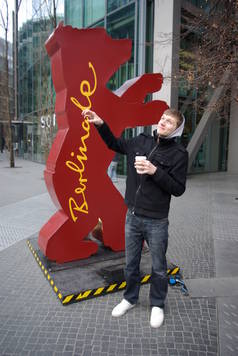
BERLINALE 2009: "Aguas Verdes" by Mariano De Rosa (Argentina)
March 3, 2009
Denise Kripper (2009, Argentina)
If we relieve in symbols, like the main character Juan does, then the red mate among the dirty cutlery in the first shot of the movie marks the onset of the story. But for the moment, everything is happiness. It is summer and the family is finally ready for a well-deserved vacation. And off they go to the Argentinean coastal town of Aguas Verdes, which gives name to Mariano De Rosa's film debut. The depiction is precise: the fishing, the yelling, the sun bathing, the quarreling, the beach, the temporary friendships and the summer loves. The sexual awakening of Laura, the daughter, triggers the hidden fantasies of everyone around her. For the most part, this movie is a comedy, but soon the atmosphere begins to change, as the stink of rotten fish begins to thicken the air. The catch was a present given to Laura by Roberto, his knight in a shining armor and white horse (or rather with a shiny fake tooth and a motorcycle) that proves to be everything Juan, her father, is not. Little by little we are absorbed in his parental point of view, full of jealousy and paranoia, and we start looking at things as an outsider, as someone who has been left out of the picture on purpose. The line between what is real and what constitutes Juan's paranoid fantasy is blurry, as the characters make a 180 degree turn. The ending is sudden, abrupt and confusing, when Juan finally decides to confront Roberto in a way that is totally out of character. The ending catches us by surprise, just in the way that a seagull attacks its prey.
The style of the film is somewhat confusing as it starts out as yet another Argentinean movie dealing with local customs, yet ends on a highly symbolical note. The audience was puzzled by the number of loose ends it left, and this showed during the Q&A after the screening, as the director received questions about what actually happened in the movie over and over again. As one might have expected, he gave no satisfactory answer.
The performance of Alejandro Fiore in the role of the father and that of Diego Cremonesi as his counterpart deserve a special mention, as they form the duo that keeps this movie going.
Although funny for moments, this film finds its place in the rather long list of movies that seem to be funny for an Argentinean audience but that don't really travel particularly well.

BERLINALE 2009: A Horse Is Not A Metaphor
February 28, 2009
Brindusa Birhala (2009, Romania)
American experimental filmmaker Barbara Hammer was present at the Berlin International Film Festival this year with her newest production, entitled A Horse is Not a Metaphor. The thirty-minute film explores details of the director's biography, with a strong emphasis on her struggle against ovarian cancer. For a public as yet unaccustomed to the work and person of the artist, it was extremely suitable to have her film shown alongside a selection from her experimental films in the late 80s and 90s. In the talk after the showing, Hammer was bursting with vitality and confessed that she is enjoying the return to experimental film after many years of shooting documentaries; although she did not intent to make a film about a tragic period of her life, she picked up the camera as a means of recovering from the torments of chemotherapy. Hammer has been for over two years in remission from cancer; thus the feel of the films is extremely positive, focusing on the moments of recovery and normality which followed the remission of the disease. It took 10 days to put the material together, and an of average 8 hours of unprocessed film was used to obtain 1 minute and 30 seconds of what she calls her "essay film."
For A Horse is Not a Metaphor, she uses the peculiar music of composer and performance artist Meredith Monk. Powerful images of Hammer in the hospital, unrecognizable as she undergoes treatment, are superimposed on her swimming naked in a river, or riding a horse. The film deals with the fragility of the female body, but at the same time captures feminine strength, in shots such as women rodeo-riders mastering their stallions. Animals play an important part, as a prevailing theme of the film is the close relationship of the artist with the animals in her life. She is shown bathing in the middle of nature in the company of her dog Spooner, or filming from horseback. Dialogue is scarce, incorporated in lyrical phrases describing the artist's inner experiences, "I want to be a bird migrating", "Horse and I are one", intercalated with textbook descriptions of the symptoms tormenting her.
The retrospective contained also Sanctus, and Vital Signs, two experimental films not too distant in subject-matter from A Horse is not a Metaphor. Made in 1990, Sanctus was born out of the serendipity of the artist's encounter with cineradiograpy; while visiting an old medical centre in New York, she found some moving x-rays belonging to the medical researcher James Sibley Watson, inventor of the optical printer and early experimenter in motion pictures in the 1920s. In this work, Hammer tried to inhabit his spirit, and by manipulating his frames of skeletal human structures, she aims at portraying the liquidity of the body, its hidden fragility and need of protection. One can recognize that her latest film incorporates some of the material in Sanctus.
The 10 minutes experimental film Vital Signs speaks of something beyond the apparent obsession with the body. It seems to explore a connection between eroticism and death, and to bring this into the realm of the personal, through shots like those of the artist dancing with a skeleton in a wedding dress. Even more evocative of her personality is her 1989 film Still Point, shot in super 8 and optically printed, in which she wanted to discover how "4 screens can talk to each other." This film marks the beginning of her investigation of questions of gender difference and her interrogation of social attitudes to homosexuality. Shortly after having met her life-long partner, Hammer describes the uncertainty and insecurity concerning their gay relationship, having amorous scenes in the desert played against grey, subdued images of New York streets. Barbara Hammer is regarded as a precursor of the exploration of gender issues though experimental film and the artist behind some of the first films in history affirming authorial identity as principally lesbian in nature.
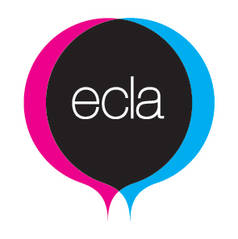
THE FIRST BA IN VALUE STUDIES AND A NEW EUROPEAN APPROACH TO LIBERAL EDUCATION
February 26, 2009
Press Release
In October 2009 the European College of Liberal Arts (in Berlin, Germany) will introduce a 4-year degree programme leading to a Bachelor of Arts in Value Studies. This programme, the first of its kind worldwide, represents a new European approach to liberal education.
In Europe, it is common for general education to take place in high school, while the years in higher education are dedicated to single-minded vocational or disciplinary training. It is not clear, however, that this system serves us well. In an age when technological progress is miles ahead of our general conceptual abilities, and when our global institution-building is far too crude for us to meet the political, economic and cultural challenges we are confronted with, it is time to improve our level of general education. Specialization is no doubt a necessary element in higher education, but it can no longer seriously be considered sufficient. We need young people who can see the connections between the expertise by which they make their livings and the larger concerns of mankind. And we need to change the mindset which discourages curious and ambitious young people from spending time on the only kind of education which can prepare them to address these concerns. To close the current gaps, we should (among other things) strengthen the level of general education both in our high schools and in higher education.
To serve this end, the European College of Liberal Arts has been created as a college without departments, dedicated to the integrated study of values. A young faculty, recruited from some of the best research universities in the world, has designed the BA in Value Studies for students who want to combine their pursuit of special interests with a demanding studium generale. In every part of the BA programme, students work with faculty from different backgrounds on moral, political, epistemic, religious, and aesthetic questions, with the understanding that such questions are naturally and deeply connected. Students spend half of their classroom time in a 'core course' devoted to fundamental questions about values, addressed through the close study of texts and works of art that have shaped, or seek to shape, the values we live by today. Against this background students choose two out of three possible areas of concentration: Art & Aesthetics, Literature & Rhetoric, Ethics & Political Theory. In this manner the BA programme is designed to provide not only a very high level of general education, but also excellent support for students interested in careers in politics, organizational work, public policy, law, journalism, or the art world. The programme also prepares students for continued study in academic disciplines such as philosophy, literature, political theory, and art history.
The ideals of liberal education have their origin in the European intellectual tradition. In the 20th century, however, these ideals have been upheld, at least in higher education, mainly in the United States, where the two most common models of liberal education are the great books programme and the distribution requirement model. Instead of simply adopting one of these existing models, ECLA has chosen a more ambitious route. Through a series of curricular experiments that began in 2002, ECLA faculty have reformulated the classical ideals and developed a new 'value questions' approach to liberal education. The first premise of this approach is that questions about values have a predisciplinary claim on all of us: we discuss questions about justice, beauty, truth and other values around the dinner table with family and friends long before we go to universities. Placing such questions at the centre of a university curriculum is unusual, but has many advantages. An ongoing concern with value questions results in academic training that is not merely academic, but relevant far beyond academia. A curriculum focused on value questions allows academics from many different backgrounds to work together with a shared sense of purpose. It promises a better integrated liberal education than the distribution requirement model, and is more flexible than the great books programme. It is also an approach that invites dialogue between different cultural and political commitments, and reflection on the relation between theory and practice. Most importantly, perhaps, the value questions approach educates the student not just as a future worker, but as a person and citizen. Good value questions always engage and challenge us personally. And the dialogues such questions inspire are, ultimately, ongoing explorations of the extent to which we can find common normative ground for shared lives. As Plato's Socrates observed, disagreement about values is a source of anger and enmity. By addressing value questions together, ECLA students educate themselves to inhabit a common world.
ECLA is a private, non-profit institution of higher education. The college has been running an International Summer University since 2000 and one-year programmes since 2002. The BA programme in Value Studies is the next big step in a project that is meant to put liberal arts back on the educational map of Europe.
ECLA has no religious or political affiliations. The college is supported by a philanthropic grant from the Christian A. Johnson Endeavour Foundation in New York that makes it possible to maintain a need-blind admissions policy and a world-class faculty student ratio of 1:7. Most of the teaching is organized around small discussion seminars and one-to-one tutorials in the Oxbridge style. Students and faculty come from all over the world and work together in English. Students live and study together on a small residential campus created around 8 renovated former GDR embassies in Berlin.
ECLA co-operates fruitfully with several other institutions of higher education, most importantly Bennington College in Vermont, Bard College in New York, and Bucerius Law School in Hamburg.
To schedule a campus visit or an interview, please contact:
Fiona Schnüttgen
Platanenstr 24
13156 Berlin
Germany
Telephone: +49 30 43 733 0
Email: f.schnuettgen@ecla.de
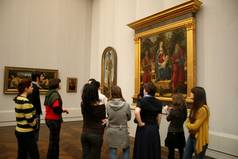
AY CORE COURSE: AY Seminar at the Gemaeldegalerie
February 23, 2009
Elena Volkanovska (2009, Macedonia)
Owing to the immense number of opportunities that Berlin offers, the students of the AY core course managed to get a first-hand experience of some well-known art works that have been the subject of study for the past few weeks. Another of the AY core seminars, led by Professor Aya Soika on February 14, was held in Berlin's Gemaeldegalerie, famous for housing one of the best collections of European art from the 13th to the 18th centuries. What made it suitable for our visit was the fact that one of its main sections is dedicated to Italian painting from the 13th to the 16th century.
The Gemaeldegalerie was first opened in 1830. The present-day building, however, was built in 1997. The architectural style tries to create a setting in which the paintings will be shown in their true splendor. A special attention is paid to light, which comes from the big windows on the ceiling, and there is even a "piazza" inside - a huge space where no paintings are exhibited and where visitors can just walk, enjoying the freedom that this spacious hall offers.
Aya opened the seminar by showing how a connection has been made between Giotto di Bodone and Mark Rothko. Three paintings, two by Giotto (Crucifixion and Death of the Virgin) and one by Rothko (Reds), were exhibited in a small, cube-like room. The fact that only a limited number of people could enter the room at once created an atmosphere of serenity similar to that of a church. This was done with the intention of giving the viewer time and space to contemplate the art presented. As Rothko himself had said: "silence is so accurate."
This artistic, and at the same time, highly spiritual, experience was continued by looking at works by Masaccio, Fra Angelico, Piero della Francesca and Piero del Pollaiuolo. These painters are each eminent in a different way: for their manner of arranging space, for the complexity of their compositions, for the use of depictions of shadows in water. Piero del Pollaiuolo's painting, Annunciation, employs a highly religious theme as an occasion for the innovative presentation of an interior and of space, one that demonstrates the painter's knowledge of the rules of perspective. An analysis of some of Botticelli's paintings followed Pollaiuolo: San Sebastian, Madonna and Child with eight Angels and Venus. The students took a particular interest in discussing the way in which Botticelli presented women's bodies, the proportions that he used, and the notion of beauty in his time. Venus was the painting that attracted the most attention: some students said that although its proportions were not perfect, it still managed to be beautiful and enchanting. This compositional effectiveness was exactly what made Botticelli a genius.
The voyage through the Renaissance ended with a Rubens' painting - his portrayal of San Sebastian. Students compared this version with Botticelli's and discussed the differences, as well as the reasons for depicting this very famous theme in such a different manner. Botticelli's painting was probably his first painting of a male nude body; he portrays it as weaker, less muscular, than does Rubens. Botticelli painted the ascetic saint: one that only cares for the life of the soul, who has retreated into a life of the mind, paying no attention to nature and the physical world. Rubens, on the other hand, gave "life" to the saint's body; made it more solid and endowed it with physical beauty, making it sensual even in its suffering. Both paintings had an impact on the time in which they were painted and even now serve as a proof of how art changed through history.
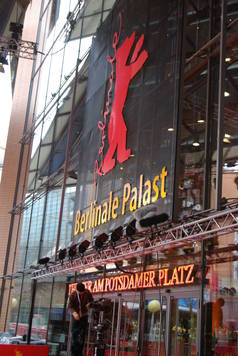
BERLINALE 2009: Between Magic and Accident
February 19, 2009
Alina Floroiu (2009, Romania)
The Berlinale Talent Campus #7 hosted an informational panel discussion on that elusive array of forces (popularly dubbed fate, chance, or destiny) that exert decisive influence in movies. Convened under the title "Fatal attractions-On Chance and Accidents in Cinema," the panel, moderated by Dorothee Wenner, included Indian producer Sunil Doshi, Peace Anyiam-Osigwe, founder and CEO of Africa Movie Academy Awards, Albanian actress Arta Dobroshi, and French filmmaker Rapha l Nadjari.
Blind chance, sliding doors, sudden thunderstorms or recently-returned, long-lost relatives often mark the difference between coincidence and fate. The recipe for different genres dictates different degrees of chance; similarly, regional particularities in the experience of uncontrollable non-human forces inform a director's choices, providing him with the framework for his narrative. For instance, a short clip from Bollywood's 1971 classic Pakeeza showed how 'chance', in the form of a rampant horde of elephants, intervenes to help dissolve a marriage that was not supposed to happen.
In a country where cinema-going almost has the importance of a religious ritual, filmic storytelling obeys strict rules of composition: following an almost linear development (beginning-middle-conclusion), the narrative ends in poetic justice. Of necessity, good triumphs over evil, and no artifice is spared to secure that end. A by-product of the many challenges he is subjected to, the hero stands as a protector of morality and values; his unequivocal success, lavishly embroidered in color and spectacle, delights the audiences of this the cheapest form of entertainment in India. Such is the power of the expectations of the audience (aligned with the oral tradition) that the ending is written before anything else, Sunil Doshi informs us.
African cinema is no stranger to happy endings either. Struggling to emerge from the auspices of "outer forces," i.e. external financing, African cinema is in the process of finding its own voice. In the words of its representative, the African Academy of Motion Picture encourages (young) African filmmakers to aspire to exalted values. The depiction of good and evil, and the interaction with the supernatural/the divine forms a meaningful part of this process, with tradition and modernity balancing each other out. The need for a "feel-good" factor at the end of the movie remains the one constant in this transition.
For Raphael Nadjari, chance is instrumental: through improvisations with actors, no rehearsals, he lets his actors/chance develop the topic. As such, by bringing in testimonies from their lives, the actors share the process of film-making with the director, resulting in "truer scenes," which encourage the more intensive attention from the audience. This "wild dialectical process", fueled by the actors' courage, puts the question of chance itself, rather than the finished product, the 'film', in the spotlight.
The short scene from "Le Silence de Lorna," starring Arta Dobroshi, told of a woman who takes destiny in her own hands. Married to a drug-addict, she tries to divorce him by going to the police with self-inflicted injuries. A stranger perhaps even to herself, she is transformed, humanized by taking the reins of destiny in her (self-abused) hands. Eerily enough, her turmoil remains hidden inside, behind her silence; the momentous enslavement of destiny is as such deeply human.
The ensuing Q&A session threw the ball in the audience's court, for a brief discussion of the freedom of the scriptwriters to insert any and all elements of fate or accident. Nadjari spoke in favor of deus ex machina, a subject which many filmmakers regard as taboo. To complement his view, he referred to the "philosophical" distinction between "destiny as essence" and "destiny as experience," leaving the matter open for further exploration. Lastly, although the panelists seemed to defend a universal storytelling, and consequently a universal/all-encompassing idea of the 'hand of destiny', the question remains whether there is a clear rift between East and West on the question of destiny, i.e. that the latter tradition depicts the evasion of fate, whereas the former highlights its controlling power.

"SIGHT IS LIGHT" by Ioana Muntenescu
February 18, 2009
Elena Volkanovska (2009, Macedonia)
Photographic records of experiments with light and dark are guaranteed to make for an intriguing exhibition. "Sight is Light", hosted by ECLA, took place on February 4, in the Lecture Hall at Platanenstrasse 98. The photos were taken by Ioana Muntenescu, a former student of ECLA.
The title was inspired by Ioana's interest in sight and its impact on the representation of figures, either in paintings or in photos. She wrote on the subject in her thesis paper before graduating from the University of Bucharest and it was also a part of her research during the project year at ECLA.
A good photo depends on many things, some of which are the use of contrasting elements; of catching the right moment, the right ray of light, and the right shadow. It also depends on the ability to discern the spot from which the reflection of the inner image in the photographer's eye is best transferred onto paper. The photographs shown were chosen from a collection made over the course of three years. They had been taken in Bucharest, Berlin, Prague and Rome. Although urban life was the main theme, the photos depicted a more peaceful and tranquil side of it. Some of them made a connection between the urban and nature, but never abandoned the original idea; moulding nature in the context of the city. A fallen leaf on the sidewalk, a river flowing through the city, even a garden in the heart of the modern concrete fortress-nature was given a mellow, somewhat melancholy touch.
Shadows played an important part in the exhibition. Sometimes the objects that cast them were missing and the dark shade on a wall, on the ground, or on a sheet was the only evidence of both the presence and absence of certain objects "outside" the photo. Another recurring image was flowers on a window-sill. There were black-and-white photos, but also photos that were rich in striking colours, which added to the impact they left on the viewer. One group of photos gave a playful note on architecture, choosing different angles of positioning the camera. Thus, it seemed almost possible that the roofs of houses could be sewn like patches or that a house could hover in the air.
The exhibition gave the viewer a singular perspective on surroundings usually perceived as common and monotonous. It provoked discussion of the beauty that a city can show, even on a cold, grey winter afternoon. The selected photos told a story of urban aesthetic explorers, who are always looking for the perfect place and moment to capture an image.
Ioana Muntenescu is a freelance cultural journalist, photographer and event creator. She studied journalism and communication, PR and advertising and received her Masters degree in theory and practice of images from the Bucharest University of Architecture and Urbanism. She was an AY and PY student in ECLA from 2003 to 2005, dedicating her project year to Francesco Guardi's vedutas and ways of looking at the Venetian city.

ALL THE WORLD'S A STAGE
February 18, 2009
Brindusa Birhala (2009, Romania)
When you're in Berlin, and it's freezing cold, do like the Berliners do: retreat somewhere inside where there is both enchantment and entertainment. A little café and a gleeful group of friends could be enough, but one should not disregard the arts either. The city's cinemas and theaters can generously contribute to the getting-to-know-Berlin process in an unforgettable manner. To give respite from wrestling with the German language in class, occasional projects are pursued by language coordinator Dirk Deichfuss and students. One such project was an evening at the Comedy Theater on Kurfϋrsterdamm, which combined crowd gazing with three hours of a surprising Shakespeare cavalcade. Spurred by the curiosity of seeing the English bard's work in a contemporary German performance, we managed to surpass the inevitable language barrier and harmonize with the elegant crowd in the theater.
The play we went to see on Thursday evening was As You like It, a Shakespearean pastoral comedy written in 1600, which throughout time has garnered either praise or harshly negative commentary from various generations of literary critics. Some consider it either too compliant with Jacobean London public's taste, while others discover an abundance of symbols and avant-la-lettre insights into issues of identity. The play presents various transgressions at work as social hierarchies, gender differences and incompatibilities in human nature are explored.
The starting point, where the main conflicts are knitted together, is the court of Duke Frederick. The action then moves to the Forest of Arden, where the heroine Rosalind and her cousin Celia are exiled. This space prompts meditation on the human/nature relationship, as the forest becomes populated by members of the court who come into contact with the shepherds and savages already there. One of the motifs ingeniously exploited in the staging was how easy and yet how confusing it becomes to pretend to be the other gender. While living in the woods, Rosalind takes on the guise of a young boy and from within this new identity encounters and befriends Orlando, the man who has vowed his love to her. A series of complications follow, but each finds its happy denouement three hours later.
The play was directed by esteemed German actress Katharina Talbach, who also takes on two roles, one of which is the mischievous, hilarious court jester. What makes her theatrical vision interesting is the intention to reverse the original Shakespearian staging situation by using only actresses and assigning a double role to some. Talbach's career has often gravitated towards Shakespeare, starting with her directorial debut of Macbeth in 1987, and continuing with the direction of Romeo and Juliet for theater and opera, and an earlier theatrical production of As You like It at the Maxim Gorki Theater in Berlin.
Doina Proorocu (AY, Romania) offered sincere testimony on the success of the class project, by recalling one of the slapstick comedy moments in the play, when all court ladies in great pomp burst into a pop song: "I think that a classical English play set up in German for contemporary audience by a womanly crew shows us very accurately how linguistic, historical and even sexual boundaries can be dissolved. For Shakespeare is as much fun auf Deutsch, with Rosalind and Celia singing Girls Just Wanna Have Fun and a feminine Orlando as it is on a classical Victorian set. It is a good example of how cultures, historical ages and languages can intermingle." Her classmate, Elena Volkanovska (AY , Macedonia) appreciated the aesthetics of the stage and the costumes, as well as the pace of the performance which made the play "simply flow", while complemented by a "witty and amusing" choice of music.

- "If dawn breaks the heart, and the moon is a horror,
And the sun is nothing but the source of torpor,
Then of course I would have been silent all these years…"
POETRY NIGHT: Food and Melancholy
February 9, 2009
Elena Volkanovska (2009, Macedonia)
These were the verses that introduced the second poetry night. They are the opening lines of a poem written by Mark Strand, a contemporary American poet, which was published in his book Dark Harbor in 1993. The poetry night was held in the common room of Waldstrasse 15, on Friday, January 23. The topics of the night were food and melancholy. David Hayes, who read this poem, opened a discussion on the aforementioned topics, which was nourished throughout the evening by a wide range of poems.
Poems were read not only in English but also in other languages - Romanian, Russian, Hungarian, Croatian… Students also provided translations to the poems, some of which they had previously prepared, achieving great results. Others gave on-the-spot translations and interpretations of poems, which in no way meant that the translations lacked in either originality or value.
Because students read poems in their mother tongue, listeners had the enriching opportunity to feel the authentic cadence of the verse. Reading in this way also brought different cultures into the limelight, since each poem carries within its language a part of the cultural background in which it was written, no matter how small this part might be. Therefore, the discussion would often shift from the poem as a piece of literature to the conditions and context in which it was written. The poems that were read came from different literary periods. An excerpt from the Song of Songs, read by Geoff Lehman, T.S. Eliot's Four Quartets, a poem by the Russian poet Osip Emilevich Mandelstam, a poem by Emily Dickinson-and many others, read by both students and faculty, brought different parts of the world together. Besides reflecting on the given topic for the night, several poems raised questions that were discussed in the previous term's AY core course (Greek Thought and Literature on Education). Some of the poems were amusing and offered great imagery, connecting a longing for the beloved with the sweet taste of chocolate. Others, on the other hand, left a bitter aftertaste, reflecting on the alienation of the human being in modern society.
As the poetry night was approaching its end, a student decided to share one of her own poems. The poem was about a summer's day, presenting all of its hot coziness through a soft, dreamy depiction. Being reminded of the summer days is an invaluable comfort on a cold January night. Thus, an evening dedicated mostly to melancholy successfully ended on a considerably lighter note.
AY CORE COURSE: Visit to Bode Museum
February 9, 2009
Elena Volkanovska (2009, Macedonia)
Week one of the AY winter core course (Art and Politics in Renaissance Florence) was dedicated to giving students an introduction to art history as well as helping them to understand and begin to practice visual analysis of a work of art. The theoretical knowledge that was gained during the week was put into practice on a visit to the Bode Museum led by Professor Aya Soika. Students tried as much as possible to "read" a particular work of art. Using the information that they managed to draw from a work of art by perceiving it as an object which incorporates characteristics and symbols typical for a certain period of time, students tried to identify the variations of style and the changes that occurred over the course of approximately 100 years.
We began the analysis by recognizing the architectural style of the Bode Museum. It was opened in 1904 and until 1956 was called Kaiser-Friedrich Museum, named after the emperor Frederick III. In 1956 it was renamed Bode Museum, after its first curator Wilhelm von Bode. The grandiose exterior was constructed in the neo-baroque style. The interior style, on the other hand, changes-from the lavishness of the baroque, through the refinement of the classical style to reach a point where it echoes the serenity of a Roman basilic
The first object of our interest was a wooden sculpture, The Virgin with the Dead Christ, dating from 1435-which had been made in Germany. The sculpture is not as elaborate and refined as sculptures produced in Italy in the first half of the fifteenth century - the bodies of the Virgin and Christ were represented in a rather clumsy way. Nevertheless, The Virgin with the Dead Christ bears a striking resemblance to Michelangelo's Pieta, made in 1499. Michelangelo's work is made of marble and is much more advanced when it comes to depicting a natural posture in the body of both the Virgin and of Christ. The position of the bodies is the same in both sculptures, and it could be claimed that Michelangelo took a step further in perfecting the already practiced depiction of this scene of lamentation.
Virgin and Child by Giovanni Pisano, made in the second half of the thirteenth century, was the next important sculpture we looked at. It had been commissioned for a cathedral in Pisa. The clear progress in sculpturing is obvious in the careful depiction of the physiognomy of the faces of both Mary and the Christ Child. Pisano emphasized the importance of Christ by "dressing" Him in the robes of a Roman monarch - a symbolic reference to Him as future King of the people.
The urge of the artists to explore new horizons and use their gifts to experiment with representations of reality (in particular perspective), is shown in the Choir Stalls by Bartolomeo de Polli, made around 1500. At first sight there is nothing that would make these choir stalls stand out from other works originating from that period, referred to as "early Renaissance". However, the scenes chosen to decorate these stalls are not just portraits of saints, as one would expect. The usual portraits of saints alternate with images of everyday life. The reason for this was the artist's attempt to work with perspective; he chose buildings and scenes that do not strike us as particularly unique to serve his purpose, that is, in order to practice the different techniques of depicting three-dimensional images on a flat surface.
Putto with Tambourine by Donatello is noted for the interesting story behind its journey to the Bode Museum. Originally used as a statuette decorating a Baptismal Font in Siena, it was sold to Wilhelm von Bode as an eighteenth century forgery. Later it was discovered that it is actually an authentic Donatello statuette. It proves the artist's mastery in depicting a child's body; the movement of the dancing "Putto" is perfectly captured in bronze. Pazzi Madonna was the next piece by Donatello that was discussed; interesting for the fact that the technique of presenting perspective on a relief was applied to human bodies, i.e. the bodies of Mary and Christ.
The tour continued with a brief reflection on works by Tiepolo and Pacetti. It ended with an observation of wooden carvings dating from the fifteenth century, which are some of the most difficult art objects to preserve.
By visiting the Bode Museum the AY students took their first steps in the realm of visual analysis of art works, beginning the acquisition of a skill that will continue to be practiced during the entire second term.
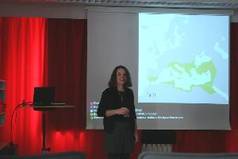
ECLA GUEST LECTURE: Lynn Catterson on Renaissance
February 9, 2009
Elena Volkanovska (2009, Macedonia)
On the afternoon of January 13, in a dark lecture hall with the only rays of light coming from the projector and the slides, the AY students began their journey through the Italian Renaissance, led by Lynn Catterson, a guest lecturer from Columbia University.
How is it decided that a certain period of time is to be labeled "the Renaissance"? What is the difference between Medieval and Renaissance art? What triggered the transition in the first place? The answers to these questions were the foundation on which the lecture was built over the course of three hours. Making sculpture as the focus of interest, we saw the transformation from the stiff, covered representation of the human body characteristic of the Medieval Period, to the grace and sensuality of Michelangelo's David. This work epitomizes the revived interest in antiquity which was directly 'responsible' for the emergence of the Renaissance.
Interestingly enough, it is Florence which is considered to be the 'birthplace' of the Italian Renaissance, although one would expect that place to be none other than Rome, since the major remains of the Roman Empire are to be found there. A peculiar event that took place in 1401, noted by Giorgio Vasari (considered to be the first art historian) in his work Lives of the Artists, offers a plausible explanation for this. Filippo Brunelleschi (1377-1446), an Italian sculptor, entered a competition, together with seven other contestants, to design a set of bronze doors for the Baptistery of Florence. He lost the contest to Lorenzo Ghiberti. Taking this as an insult, Brunelleschi decided to leave Florence and go to Rome, accompanied by Donatello, who was his contemporary and a highly esteemed sculptor. What they found in Rome was a treasure of monuments from the ancient Roman Empire, which were subject to the sculptors' close examination. What is more, they excavated "pieces of capitals, columns, cornices, and bases of buildings buried underground". The people of Rome were not used to this, and they even mistook Brunelleschi and Donatello for "treasure-seekers". It is through these two artists' discoveries that the antique penetrated the artistic values of medieval art and shattered the principles on which it was founded.
Having given us a thorough introduction to the events that heralded and conceived the Renaissance, Catterson paved the way for a meticulous examination of Donatello's life and work, and the immense influence he had on the Italian Renaissance. On his way back to Florence, Donatello visited a church in Cortona. There he discovered a sarcophagus dating form the second century A.D. which depicted a battle scene between Dionysus and the Amazons. Being impressed by it, he made drawings which were to influence the work of Florentine sculptors. Although they had never seen the sarcophagus, these other artists were keen on incorporating some of the ideas and techniques that they saw in the drawings. Another theory is that Donatello re-carved the sarcophagus in order to 'cover' its damaged parts. Catterson rounded up the lecture by presenting students with interesting details about Michelangelo's work and his methods of producing sculptures that closely resembled the antique. Namely, he was aware of the mathematical proportions that govern classical art and make it reproducible. He made use of these proportions in his work, knowing that ancient sculptures were invaluable during the time in which he lived.
Lynn Catterson is a lecturer in Art History and Archaeology at Columbia University, New York. She received her PhD in Art History from Columbia University in 2002. The main subject of her research is Italian Renaissance sculpture, with an emphasis on fifteenth century Florence.
Her works include Donatello's Legacy and the Training of Michelangelo, published in 2008; "Michelangelo's Laocoön?" Artibus et Historiae 52, 2005 and "Bertoldo and Middeldorf, Both Again," Artibus et Historiae 51, 2005.
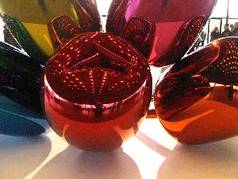
Commemorating Childhood in "The Cult of the Artist"- Paul Klee and Jeff Koons at the Neue Nationalgalerie, Berlin
February 9, 2009
Brindusa Birhala (2009, Romania)
While waiting in the long queue in front of the Neue Nationalgalerie these days, one has the opportunity to experience once more that forgotten child-like enthusiasm before a magical encounter at the puppet theatre. The shows on display until February fascinate the visitors from two different standpoints: the grand and the minute; 11 giant sculptures by American contemporary artist Jeff Koons are hosted under the same roof as about 250 paintings of the Swiss artist Paul Klee. After completing the essay of the week, ECLA students approached both exhibitions with greedy eyes, re-tracing the "Cult of the Artist" theme, which major museums of Berlin are currently employing to organize their exhibits; in the present case, the focus was modern art. Not accidentally, the winter term will offer an entire elective course on the Cult of the Artist, coordinated by art historian and ECLA professor, Aya Soika.
The "Koons Celebration" series, which covers the entire ground floor of the museum, toys with the visitors' perception by transposing everyday objects into immense, brightly-colored sculptures which unmistakably refer to childhood. The artworks produce the unreal, yet playful sensation of the viewer being very tiny. Who would have thought that the world-famous Balloon Dog in its red version would be so big, so stainless-steel-shiny, and yet so adorable? The pieces on display at the Neue Nationalgalerie are the result of a preoccupation of the artist with sculpture since 1994, and the present show gathers the largest number of such works at once. While lingering at each one, we recognized our tired reflections in the perfectly polished surfaced of Koons' Diamond (Yellow) or Hanging Heart (Violet / Gold) and pondered the contemporary art market.
Although Koons entertained our imaginations, the final destination of our class visit was Paul Klee, or more precisely, the large grouping of pictures on display amounting to only 3 percent of his prolific output. We descended to the basement of the museum, and were told by our guide that the architect of building (Ludwig Mies van der Rohe) was a collector of Klee's works. Where could be a more fitting a location to present a part of the artist's creative universe? The entire exhibition is structured around 15 themes recalling the artists' theoretical considerations about the universal character of art, which, in its essence, accompanies and represents human life from its magical inception until its melancholic demise. The person of the artist, as well as his worldview and theory of aesthetics become transparent in some of his most widely discussed works, which were also the focus of our attention: "Ad marginem", "The Sealed Lady ( versiegelte Dame)", "Angelus Novus", and "Highways and Byways (Hauptweg und Nebenwege)". The title of this last piece is also the title of Heinz Berggruen's biography; he was one of the most ardent consumers of Klee's work, having collected a very large number of paintings, and contributed to the planning of the present Klee Universum exhibit until his recent death in 2007.
Childhood, Eros, travels, theater, animals, nature, music, architecture, Bauhaus, script, religion, war, and melancholy are points of reference for the artist. Out of these one can reconstruct the most relevant experiences in Klee's philosophic and artistic development, leading to his ascription of an integrative role for art: "art does not reproduce the visible; rather, it makes visible."
He found great insight and value in children's visual representation of the universe surrounding them, and involved himself with artists displaying the same inclinations, like Kandinsky and his "Blue Rider" expressionist circle. His fascination with forms and elements outside the canon urged Klee to pursue the artistic expressions of non-European cultures. His travels to Tunisia and Egypt further inspired the themes of colour, composition, and rhythm, which were never absent from his painting. Music was the medium of the first artistic manifestations of young Klee, thus he often quoted and employed it as a concept, at times in praise of childhood and its creative strength.
The ten years Klee spent as a Bauhaus professor imprinted a tendency toward abstraction and the predominance of dynamic and architectural motifs in his work. Arrows, letters, and vivid colour are intensively used for their power to communicate with and incite the viewer to contemplation. One can perceive a foreshadowing of what was to be coined conceptual art in Klee's use of script, and also in the theoretical considerations behind his works. His post-1933 work deals with the pressure of having had his art publicly contested as "degenerate art", and transmits the violence behind the Nazi threat in paintings which appear unfinished or repudiated--collage portraits crossed by long black strokes of the brush.
A world of interpretations surrounds one of the central pieces of the exhibit; the 1920 painting entitled "Angelus Novus", which has been commented as Klee anticipating the advent of dictatorship in Germany. Having owned this painting, the philosopher Walter Benjamin used the image to metaphorically contour his concept of history: "An angel is depicted there who looks as though he were about to distance himself from something which he is staring at. His eyes are opened wide, his mouth stands open and his wings are outstretched. The Angel of History must look just so. His face is turned towards the past. Where we see the appearance of a chain of events, he sees one single catastrophe, which unceasingly piles rubble on top of rubble and hurls it before his feet. He would like to pause for a moment so fair, to awaken the dead and to piece together what has been smashed. But a storm is blowing from Paradise, it has caught itself up in his wings and is so strong that the Angel can no longer close them. The storm drives him irresistibly into the future, to which his back is turned, while the rubble-heap before him grows sky-high. That, which we call progress, is this storm."
PHOTO EXHIBITION AT ECLA
February 3, 2009
On Wednesday 4 February European College of Liberal Arts will be hosting a photo exhibition of a special kind. Ioana Muntenescu, a former ECLA student (AY 2003/04, PY 2004/05) will be presenting a selection of her photos under the theme "Sight is Light".
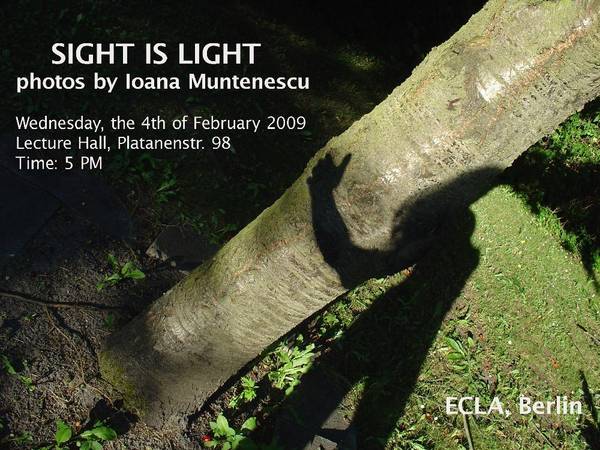

ECLA GUEST LECTURE: Stephen Houlgate on Hegel's Theory of Tragedy
January 28, 2009
Elena Volkanovska (2009, Macedonia)
On Wednesday, December 10, the AY students had the opportunity to attend a lecture on Hegel's Theory of Tragedy given by Stephen Houlgate of the University of Warwick. The lecture not only addressed issues discussed during the AY core course, but it also incorporated topics that were of interest to students taking the electives on Philosophy of Greek Tragedy and Greek Polis in Hegelian Perspective.
The first topic beginning the lecture was the Hegelian definition of tragedy. Houlgate introduced Hegel's views by saying that according to Hegel, the origin of tragedy lies in a human life that "is governed by the ideal of heroic individuality". A widely accepted notion of tragedy historically has been that it is caused by an external force, sometimes referred to as fate, which has an immense governing power over human lives and actions. However, for Hegel, tragic fate is self-imposed, a result of the convictions and beliefs of the tragic hero.
When discussing and comparing Greek to modern tragedy, it is relevant to make a clear distinction between the motives and the traits that make the tragic hero truly tragic. For the Greeks, tragedy arises from the fact that the characters pursue their convictions, which are a direct result of their own ethical pathos, and which fail to meet the beliefs of the opposing side. This one-sidedness and insistence on one's own rectitude, together with the strong determination to follow and practice incomplete justice as such, inevitably leads to the character being punished by the "other" side of justice, the one that is being ignored. Characters are both right and wrong at the same time, fuelling this conflicting position with a rigid pursuit of the individual right, thus making their fall the only way to restore the balance. Sophocles' Antigone is taken as an example of the tragic outcome of the clash of two individuals who fervently believe that what they are doing cannot possibly be wrong. Creon has been seen by many as a tyrant; however, Hegel's reading of the tragic traits of the play proposes that both Creon and Antigone are victims of their own blindness to see the justification of the other side's claim. The tragedy is established in the fact that Creon and Antigone do "wrong in the very act of doing what is right". Antigone does what is right for the family; Creon protects the law of the state. Oedipus Rex does not present a clear-cut strife between two ethical powers, but nevertheless contains the thread of pursuing one's own pathos and being responsible for the tragic end. Hence, Hegel does not see as tragic the fact that Oedipus kills his father and marries his mother. The tragic element for Hegel lies in Oedipus' failure to recognize the unknown and unconscious and insistence on practicing the "right of the wide awake consciousness". Therefore, Oedipus consciously seeks the truth which brings upon the uncovering of his own crimes.
Hegel analyzed modern tragedy mostly through the works of Shakespeare. The fundamental difference, Hegel claims, was the fact that the tragic heroes in modern drama are not led by a one-sided justifiable drive, but by motives that could be regarded as "personal passion". Although these characters may be irresolute in the beginning, once they take action there is no force that could stop them. What makes such characters heroic is their brutal magnificence. The overlapping points with Greek tragedy are the facts that they are not passive victims of fate and that they are truly victims of themselves and their inability to "let go". The difference between Greek and modern tragedy is in the experience they offer to the audience as tragic plays, in the sense that they have a different way of claiming that "justice has been served". To Hegel, the downfall of Greek tragic characters is demanded by reason and justice, reconciliation is achieved with the fact that "the ethical powers which animated them (the characters) are accorded equal recognition and so reconciled". Modern tragic justice revolves more around the axis of receiving the deserved punishment. A more complex reconciliation is possible only in the mind of the tragic figure, either by repenting or remaining unchanged to the very end.
According to Hegel, tragic outcome can be avoided, as is in Goethe's work Iphigenia auf Tauris. Some critics argue that here there is not any tragic element to begin with; to Hegel, though, the tragic element is the fact that Iphigenia entrusts her faith in the hands of a man who is unpredictable, building up a tension because of the fatal consequences that this act could have had. Nevertheless, everything is peacefully resolved owing to the fact that Iphigenia chooses to trust human nature.
Houlgate went on to explain that this should not be regarded as an optimistic reading of tragedy, but it should be understood as a possible reconciliation since it stems from Hegel's theory of tragedy - that it comes from the actions of the individual and thus it can be resolved only by the thought and deeds of the individual.
The lecture concluded with a discussion, during which students and professors together tried to reach an agreement about how tragedy should be seen, and what is to be regarded as truly tragic. Plato's Republic was also discussed, bearing in mind the fact that Plato considers tragedy as harmful to the individual's soul.
Stephen Houlgate is Professor of Philosophy at the University of Warwick. He is the author of "Hegel, Nietzsche and the Criticism of Metaphysics" (1986) and the editor of "Hegel and the Philosophy of Nature" (1998), "The Hegel Reader" (Blackwell, 1998), Hegel and the Arts (Evanston, IL: Northwestern University Press, 2007) and G.W.F. Hegel: Outlines of the Philosophy of Right (Oxford: Oxford University Press, 2008). He was President of the Hegel Society of America from 1994 to 1996 and is currently editor of the Bulletin of the Hegel Society of Great Britain. After having written numerous articles concerning the philosophy of Hegel, as well as that of Kant and Nietzsche, his further interests include essays on Hegel's philosophy of action and on Kant's philosophy of history and an essay on Hegel's account of quantity in the Science of Logic intended for a collection of essays on the Logic to be published by Felix Meiner.
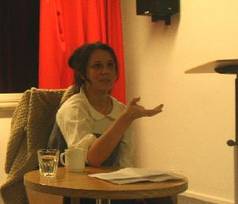
ECLA GUEST LECTURE: Rivka Galchen
Authorship and Authority; or, An argument for not writing your own novel.
January 27, 2009
Brindusa Birhala (2009, Romania)
How can science relate to literature? Is a novel with a scientific backbone necessarily concerned with problems of objectivity? Can science be emotional in any sense?
It was both exciting and daring to mingle these questions and many more in the presence of Rivka Galchen, the last guest lecturer for the Autumn term at ECLA. She is the author of freshly-published novel Atmospheric Disturbances, which was included in the Project Year Core Course on 'Objectivity' by ECLA professors Catherine Toal and Bruno Macaes. Only ten students (PY) had the chance to experience Rivka's writing, but having an open lecture offered the entire student body a glimpse into her understanding of authorship. Attracted to oppositions and paradoxes, though refraining from qualifying them as such, the young author declared that she was flattered by critical reviews of her style as 'masculine'. From her perspective, authorship presupposes a form of detaching from the real self and submitting to 'another' who takes charge of putting fiction on paper. The process materialized successfully in her first novel, Atmospheric Disturbances, which is narrated by the character Leo, a middle-aged psychiatrist engaged in constant analysis of himself and his surroundings.
Rivka Galchen shared with us insights about the project of the book. Her purpose was to take ordinary pain and make it into a case of hysteria. Leo is haunted by the imaginary disappearance and replacement of his beloved wife, but while trying to retrieve her, he wanders further into uncertainty and loses himself. The novel incorporates a few auto-biographical elements, like pictures of the author's family, excerpts from her father's meteorological research, and even his name. These details reveal how much of reality Rivka's authorial 'other' is allowed to present.
Coyly she confessed to the students: "If I felt like I had very much to say to people, I would not be a writer." In spite of her professed timidity, she does have much to say and to write to people, being primarily drawn into literature by the sensations it produces, and by the manner in which general truths can be recalled and modified in fiction, as through a grinding machine. When white noise stands out from the rest, for a few instants, and rubs against one's eardrums, realism enters one's life, and also one's writing, she explains.
As for the relation of science to literature, it is enough to mention that our guest is a physician, a writer, and a professor. And science in the novel is exemplified by psychoanalysis and meteorology! The ambivalence between reverence for and revolt against the authority of science is what enticed Rivka into creating a character who takes up "the rhythm, the cadence, the vocabulary of science, even as he so obviously misappropriates them to whatever purpose suits his emotional needs. He convinces himself that he's turning to science for authority, when really he's cloaking himself in its mystery." In writing, she aims at being "rigorously playful" which one can sense in the construction of Leo. She advised that by letting the process of writing influence you back, as much as you control it as an author, you can create more than you already possess.
Esteemed literary critic James Wood (whose latest book, How Fiction Works, is also a part of the PY core course) describes her novel as "original and sometimes affecting, one that knows how to move from the comic to the painful." In a "consensus view of reality" (a gripping recurring phrase in the novel) one cannot but agree with him, and be seduced by emotions laid out with their opposites, in puzzling, but aesthetically pleasing ambivalences.
Rivka Galchen is currently teaching creative writing at Columbia University. She received her M.D. in psychiatry from Mount Sinai School of Medicine, and completed a Master of Fine Arts at Columbia.
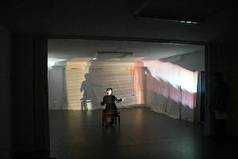
INSTALLATION ART: Showing You How We Play
January 26, 2009
Brindusa Birhala (PY09, Romania)
Why did I opt for the Installation class at ECLA? It was not because we do not have to write any papers; to balance this "advantage" there are many hours of practical work involved, not to mention the inevitable creative blocks and the concerns over possible technical break-downs during showings. I joined out of appreciation for this form of art, which I often find incomprehensible and yet intriguing. I wanted to construct an experiment about how creative can one become with close to zero background in any artistic field. What I discovered: installation art is a slice modern of art so flexible and open to the public that anyone can consume it, and as a result, be inspired, in turn, to produce it. To be honest, I experienced that playing with technology today helps one not be embarrassed by lack of craft, or even lack of talent. Setting the imagination loose and then giving it the necessary form, or surrendering to the games of chance while creating a piece are the two creative options whose interplay I find most useful in this class.
We have eight students enrolled in the class taught by ECLA professor David Levine, and the funny coincidence of an all female group. The course is structured according to the main media of installation art: sound, light, and video. In the first weeks, we immersed ourselves in theoretical discussions about the practice of this form of art, its reception, and the renowned artists to which Claire Bishop refers in her book Installation Art: A Critical History. Meanwhile, the practical task was to learn how to manipulate sound, video, or how to program lights. Every two weeks, on Wednesday evenings, each student opens her studio to the entire ECLA community and its guests, for an event entitled 'public showing'. Part of learning and teaching something which apparently requires no instruction is the common class critique, the morning after the showing, where the pluses and minuses of our week's work are spelled out without remorse.
This week, dedicated to video installations, offered every visitor something of personal interest; the media of expression and the subjects of the pieces happened to be widely varied: performance, aesthetic spaces, love, comedy, abstraction, music, and politics. The imposed restriction (read: 'class assignment') was to have a video of at least 3 minutes in length, shot in the studio, and digitally edited.
Elizabeth Hanka kept our attention the longest, with her 26 minute-piece entitled "Colour Play" which was a projection of a performance, which mirrored an actual performance. She calmly painted one of her studio walls in rainbow coloured stripes, while opposite this performance, you could see Elizabeth again, in a video of the exact same action. Observing people carefully watching Elizabeth reminded me of a tennis match, where heads turn from one side to the other, the difference being that the focus was not on a central object, but on the extremities of the space.
Across from her studio, Lorena Baric used video projection on a paper screen, red light and a disco ball, to create an ambiguously feminine atmosphere. We all left her studio singing "your love is mine", the almost-hypnotizing refrain on a loop which she used as the audio background for her installation.
From Isolina Rivarola Lopez's studio, one could hear passionate screams. Two young lovers separated were struggling to reach each other, trying to break free from two opposite walls of the space. To enhance the visual experience, she played a touching melody behind their desperate cries. Afraid of trespassing into personal anxiety, nobody asked the artist for further explanations.
Our Russian classmate Anna Dushina offered an amusing, but perturbing piece-a video projection of a little object in a parody of a dance. With clear references to pop culture, Anna inserted split-second frames of a whole banana, observable only after having spent more time with the video. She claims that she was not making art, and that the work was born out of the frustration of being in the position to present 'art'.
Ena Gojak's work was composed of two completely different videos projected on one of the walls and the ceiling of her studio. One was abstract, while the other contained self-referential touches. The audio background picked up on the abstract video, and sounded like music only Ena could introduce--fragile, strange; almost celestial.
Music also played a great role in the piece by Tatyana Ilichenko, who projected a never-ending sequence of piano keys on the ceiling; a classical-style piano bench in the middle of the empty room invited the spectator to sit and strike the keys on the screen with one's shadow.
Daria Coscodan presented a stop-motion animation of objects pilling up and populating her studio. She used split screen as video montage and a very ingenious arrangement of the projection screen to emphasize its qualities. The clear-cut rigidity of the trapezoidal paper screen on which the video was shown contrasted with the chaos of tables, chairs, and fabric in odd random movement. What I still need to discover about her piece is the identity of that frantic soprano on the background, genuinely sending shivers down our spines.
The core of my piece was a video collage, projected alongside the sculpture of a reconstructed tree, which also featured in the video. Outside the studio, one of the lights periodically lit up to reveal Lego people hanged from the branches of a garden tree. A duet of chainsaws could be recognized in the audio background.
This showing brings us all a step closer to the final one, in which specific tasks or restrictions from the professor are abolished. With more freedom, of course comes more responsibility! Ultimately, everybody will bring forward their favourite themes and subjects, and use the media they feel most comfortable with.
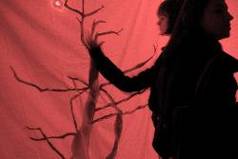
SECOND INSTALLATION PUBLIC SHOWINGS
January 12, 2009
Elena Volkanovska (2009, Macedonia)
The evening of November 12th was saved from turning into an ordinary, cold autumn night by another remarkable exhibition given by the students from the Installation class. For the second time this year, they opened the doors of their studios to the curious ECLA members and allowed them to see the fusion of imagination and reality, presented through objects, light and sound.
The showing started at 20.00 and lasted for about one and a half hours, exhibiting eight light installations. Some of them made a strong, clear point; some were subtler and, in order to be interpreted, demanded higher attention on details. The inner structure of most of the pieces revolved around the idea of self-portraits and the technique of incorporating the spectators in the piece and contradictions.
Two of the installations, in particular, stressed the idea of the "self" of the artist. In one of them, hundreds of photocopies of the artist's face, hands and feet covered the walls, the ceiling and the floor. The studio was reduced to less than half of its original size, with sheets given the function of walls and pushing the artist on the threshold between the self and the unknown. What was beyond the self of the artist was symbolically presented on these "walls": shadows of a bird of prey and of a bare, leafless tree, signifying our relative knowledge of everything other than ourselves. The second self portrait was more of a "translation" of the artist's self onto an object, which, in the end, becomes an obsession. Having seen the "kater" - a Chinese souvenir cat - in restaurants, shops, streets and markets, the artist eventually came up with the idea of collecting these souvenir cats in various sizes. Then, in the installation, this collection was made even bigger, having "multiplied" the objects by using their shadows and reflections.
The technique of including the spectators and making them a part of the exhibition was employed, to varying degrees, in four of the installations. The first one had the setting of a rather peculiar gallery or a museum, where the pictures are exhibited in darkness, except for one or two. These, however, seemed to have "a mind of their own" - as soon as someone would try to see them, the light would go off. Being left for a moment in complete darkness, the next thing that one saw was a torch, a camera and - one's own face projected on the wall. The pictures, in fact, served as a "bait" to get to the "real" object. Another inventive interactive method was used in a piece which had its own pulse. Three sculptures were shown under pulsating light, accompanied by music with a beat corresponding to the "pulse" of the light. One could easily become a part of this installation by looking into a mirror and seeing her or his own face glowing in strong neon light. A third piece involved both the artist and the audience, as if the artist was saying: "Look, this is exactly what you are doing!" Spectators were given voyeuristic roles, entering a studio which had doors in every corner, with chairs placed in front of them, "inviting" everyone to sit and peep through the keyhole. Another element in the studio added to the whole act of taking a secret look into the "otherness": a "female" beamer on a tripod projected a "male" version of itself on the wall. An inverted house in one of the corners of the studio was another curious element. The fourth piece embraced the spectators in a more delicate way: by showing them a reflection of their soul. This was brought about by reading into Plato's theory of the structure of the soul and converting it to an exhibition including dance and lights in three different colours. The movements of the dancer were captured by putting the lights at different angles, thus producing three different shadows of that movement. All of this served the purpose of showing the Platonic soul and the three different parts of it, as the artist herself explained.
In two of the pieces the notion of opposition was applied to bring out the artists' ideas. One of them had a very straight-forward, powerful approach and had sculptures of the two most contrasting words: "yes" and "no". The light shifted between these two words, guiding a puzzled voice, who, eventually said: "I don't know…"
The second piece was structured around the polarity of the natural and the artificial life. The visual effect was quite ambiguous. One way of seeing it was to interpret it as a garden, a symbol of fertility. However, if the lights and the form of the "fruits" were taken into account, this could also be seen as a laboratory, a place where life is artificially conceived.
This exhibit proved again that it is possible to extend the limit of reality and to achieve what at moments seems to be unattainable. Strong dedication to art will always be something that enriches the ECLA experience.

DRESDEN TRIP
November 17, 2008
Brindusa Birhala (2009, Romania)
The end of the first month at ECLA was marked by the group trip to Dresden and the beautiful region of Sächsische Schweiz, where the Elbe seems almost ubiquitous. At least, this image persists strongly from the trip, mostly because it was the conquest of physical striving. By leaving Berlin on Friday, ECLA students and faculty said goodbye to the urban scenery for the first part of the weekend, and set up for a closer encounter with natural scenery, trains, trekking and magnificent views. We were comfortably hosted in a small hostel in Radebeul-Weintraube, and engaged in the first ascent of the wine hills to capture the view for the first time. This small town, at the outskirts of Dresden lies on the Saxony Wine Road and has been well-known for its vineyards ever since the beginning of the fourteenth century. Having just stepped out of the train, we were welcomed by what it seemed to be an ancient toy-model of the same means of transportation, running fast and loud through the city. None of us was courageous enough to step in for a ride, but contented with taking pictures of this train making its way to the Baroque castle of Moritzburg on a narrow gauge railway.
Ex post, we can testify that the city of Meissen should not be missed during one's stay in Saxony, first of all because of the enchantment which the narrow cobblestone streets and the Medieval and Renaissance architecture produce in each visitor. We just had to climb up winding streets, to find and enter the Meissen Cathedral, one of the smallest in Europe, but also one of the most representatives for the Gothic style. The evening was dedicated to dining together, and small-scale celebration of Halloween, as a remembrance of which, we kept the pumpkin students so artistically carved.
Saturday was all about climbing, with the luck of good weather on our side. Thus, first objective conquered- the Königstein fortress, one of the biggest in Europe, also called the "Saxon Bastille", on account of its prison and refuge roles throughout history. It took a heartening upwards walk through the forest to reach it, but the effort just augmented the wonder at the sight of the 750 year-old walls, which defended elegant gardens and buildings inviting to leisure. What followed was the ascent of the Bastei, one of the main outdoor attractions in the region, which is said to have inspired landscapes by Kaspar David Friedrich. Nature competed with human ingenuity for our attention in this case too, because at the top of the massif we crossed the 76 meters-long solid bridge know as Basteibrücke in order to see a new turn of the Elbe. Despite its unbeatable image, the bridge collapsed under attacks during the 30-Year War, and was much later reconstructed in several episodes, up to the present version which dates from the 1850s, and stands at 165 meters above the valley.
The evening made the passage from the silence of the day's wanderings to the cheerfulness of spending time together in a historical restaurant which carefully conserved its brewery aspect, but blended it with the luxury of a ball house. Later on, some took to explore a bit of Dresden by night, and bravely face the traps and trials of public transportation back to Radebeul.
The culmination of the trip involved a few impressive sights of Dresden by day, a ground level view-for a change- of the Elbe, and the museum tour of the Old Master's Picture Gallery, where unsurprisingly, the Sistine Madonna captured most of our interest, making the struggle with time bitterer.
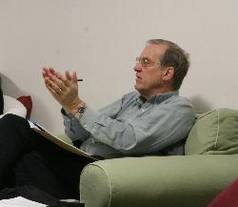
ECLA GUEST LECTURE: David Colander on Economics and the Liberal Arts
November 17, 2008
Snezhina Kovacheva (2009, Bulgaria)
On Thursday, 30 October 2008, ECLA was visited by Professor David Colander from Middlebury College, VT, USA. Colander engaged the ECLA community in a seminar discussion about what it means to think as an economist, what the future of the discipline is, and what its role is in the context of liberal arts education.
Colander began by pointing out that the goal of economics lies beyond textbook catch phrases such as optimization and efficient allocation of resources. Rather, it should be the creation of excellent decision-makers, who are instrumental not only in achieving society's goals effectively through rigorous quantitative analysis, but also in defining these goals.
To do that, one needs broad understanding of the inter-relations between various disciplines, as well as big-picture thinking in the tradition of the liberal arts education. In this context, Colander criticized the tendency within the economic discipline - especially at graduate level - to shape specialists, who devote more time to deepening their understanding of a narrow niche, and less time to addressing those fundamental questions which can be answered differently, depending on different criteria; which have no definitive solutions but also tend to be the most interesting. This phenomenon, Colander explained, might be related to the incentives for professors to do research, given that more publications usually mean faster advancement in one's career.
Colander said that although being a specialist does not preclude a broader trans-disciplinary grasp, it is nevertheless very challenging to strike the right balance between depth and breadth of knowledge (another version of this question is the allocation of time between a student's major and so-called "general education" classes at liberal arts schools). In aid to this quest, Colander saw broader applications of technology in education, which might transform profoundly the way universities operate with the changes either imposed by the emergence of other competing models for education-provision, or internally driven by the institutions themselves.
Colander discussed what he considers two differentiated branches of economics: the "economic science" branch, and the "political economy" branch, which uses the insights of the discipline to address normative goals. Colander related the origin of the former to the deductive methods of mathematics (one assumes the existence of particular conditions and works from thereon), and the origins of the latter - to moral philosophy and what John Steward Mill refers to as "the art of economics."
Professor David Colander is the C. A. Johnson Distinguished Professor of Economics at the Department of Economics at Middlebury College. Prior to Middlebury, he was the Kelly Professor of Distinguished Teaching at Princeton University. Colander has authored, co-authored, or edited over 35 books and 100 articles on a wide range of topics. He has been president of both the Eastern Economic Association and History of Economic Thought Society and is, or has been, on the editorial boards of numerous journals, including Journal of Economic Perspectives and the Journal of Economic Education.
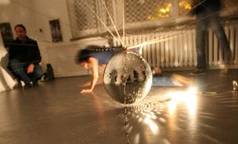
FIRST INSTALLATION PUBLIC SHOWINGS
November 17, 2008
Elena Volkanovska (2009, Macedonia)
On October 23, 2008, the students from the Installation class gave the ECLA community the unique opportunity to enjoy the first Installation Showing of this year. It was a sound installation exhibit, where each of the students had their own studio and the freedom to manage space in the way they thought would best suit their purpose.
The event started at 20.00 and it lasted until 21.30. Installations were exhibited at different times, showing two or three pieces in the course of 20 minutes. Everyone had different explanations of what they saw, but, as one of the artists said, '… we are not trying to convey a certain, definite message… we just want to express ourselves.'
The students used various materials and techniques to narrate their stories. The audience was lulled into the atmosphere by a girl's voice repeatedly spelling out 'interpret me'. The invitation reechoed as people moved through the studio, its floor covered with aluminum foil that reflected the extinguishing lights. In another studio, intensive red light wrapped a musician performing on an acoustic guitar, the song expressing his alienation from the surrounding world. Then, spectators were taken into 'The Garden', a rather intriguing piece, 'fenced' by transparent foil, that distanced us from the objects behind it: a pile of books, a broken coffee cup and spilt coffee on the floor. This gave rise to a number of interpretations from people who tried to gather it into a single, subsequent narration.
It was only natural that everyone would try to discover a meaning beyond the point of the palpable experience. Whose was that voice coughing in 'Cartonalone'? Some thought it was a voice of 'another' person in 'another' room. Others went even further, taking upon the presumption that it was a deceased inhabitant's voice of a haunted 'room within a room'. Studio 1 showed a powerful sculpture symbolizing a political movement in Argentina, cacerolazo, where people protested by banging on pots and pans in order to get attention. The sculpture itself was made of neatly ordered pots and pans in the centre of the studio, surrounded by scattered lettuce, with the sounds of people protesting. Everyday life was given an artistic touch in the installation 'All Language is Null', where seminar and lecture discussions had been recorded and turned into a sound installation. The floor was covered with autumn leaves concealing books, among which AY students were able to spy out Plato's Republic and Homer's Iliad.
A proof that the audience was not just passive observers of the event was the installation which brought its visitors - literally - to kneel down. The sun is a disco ball and the whole universe is upside down… and fastened with ropes. In order to go around the studio, one had to cross over the ropes, crawl under them, but also constantly keep in mind the barbed wire lurking in between, as a prompt of the unpredictable nature of what one might think is visible on the 'surface structure'. More evidence of the power of art was the effect that a screaming female voice had on the audience, reduced to being the blind 'voyeurs' of the act. It was completely unexpected; thus astonishing and compelling. And this was the perfect formula for leaving a strong, permanent impression.
Once again, ECLA students offered a fresh, creative blend of sound and space through which they proved that imagination is, indeed, boundless. What was witnessed on October 23 was the product of incredibly creative minds and meticulous, exhausting, hard work.
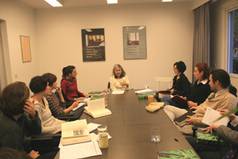
ECLA GUEST LECTURE: Discussing Objectivity with Lorraine Daston
November 17, 2008
Brindusa Birhala (2009, Romania)
The present PY core course is structured around the theme of objectivity, aiming beyond its scientific boundaries, and revealing its conceptual and practical impact in domains such as ethics, politics, or aesthetics. The beginning of the term was marked by a thorough questioning into the nature and prerequisites of the scientific self, and of objectivity per se. In the light of this task, a great deal of attention was granted to the newly published work of Lorraine Daston and Peter Galison, titled "Objectivity". The authors identify the main concern of their research as "the creation of a new epistemic virtue-scientific objectivity-that drove scientists to rewrite and re-imagine the guides that divide nature into its fundamental objects…the search for that new form of unprejudiced, unthinking, blind sight we call scientific objectivity."
The visit of science historian Lorraine Daston, the co-author of "Objectivity"gave the students in the PY core course an opportunity to inquire into the arguments unfolded in it. She offered an insightful exposition of the issues which prompted the research and the methods employed, and drew the guidelines for a better comprehension of the concept's history and transformations. She acknowledged the present over-emphasis on objectivity in an increasing number of domains, but stressed the fact that it was philosophy to contemplate objectivity first, and only later natural sciences started to adhere to it, with the growth of the scientific community in mid-nineteenth century. Legal, political and social studies have adopted it from the latter, to the purpose of enhancing their authority. The work of Daston and Galison wants to take the concept out of the present debate which is asking questions such as "Is it attainable?" or "Is it good?" and understand its actual meaning, by bringing together all the historical instances of the concept.
"Objectivity is younger than truth or certainty", claim the authors and embark to tell its story through the pictures in the long tradition of scientific atlases. The reason for this particular focus is threefold: atlases make an account of scientific practice as well as precept, they have been central to scientific practice, appearing since the sixteenth century, and are epistemologically durable, setting the standards for depiction and analysis of phenomena. Moreover, "Objectivity" represents an account of how three epistemic virtues have impacted on the scientific conscience. Their careers succeed one another and are historically determined, which might render them obsolete in the sequence: truth-to-nature, objectivity, trained judgment. It is Kant who opened the modern door for objectivity, but employed it in a different meaning than what we naturally would concur today. He constructed objective relational categories (time, space, causality) whereas today we tend to attribute to objectivity virtues relating more to the subject: detachment, impartiality, disinterestedness, even self-effacement. One of the topics discussed was the figure of the scientist as a hero renouncing all natural temptations in the pursuit of truth. Is there reason to believe that these values are still present?
Lorraine Daston is the director of the Max Plank Institute for the History of Science, where she is currently engaged in the study of history of objectivity, as well as a professor in the Committee on Social Thought at the University of Chicago. She received her doctoral degree in Philosophy from Harvard in 1979, and has held the position of Associate Professor at Harvard, Princeton and Brandeis; in 1990, she became a Professor first at Göttingen University , and later at University of Chicago , and presently is a Honorary Professor at Humboldt-Universität zu Berlin . The Relation Between Natural and Human Sciences, the History of Scientific Objects, and the Ideals and Practices of Rationality are among projects she is currently coordinating within the Institute. She published extensively, being the author and co-author of numerous works: Classical Probability and the Enlightenment (Princeton University Press, 1988) Wonders and the Order of Nature, 1150 - 1750 (MIT Press, 1998), Eine kurze Geschichte der wissenschaftlichen Aufmerksamkeit (2001), Wunder, Beweise und Tatsachen: zur Geschichte der Rationalität (2001), and Objectivity (Boston : Zone Books, 2007). She is also an established editor in her research field.

"I can't just slice off an ear everyday"
November 17, 2008
Brindusa Birhala (2009, Romania)
Berlin will always be calling, with its streets, shops, parks, bars, clubs, faces, museums, galleries, cinemas, squats, walls and under-or-above ground events. The newest inhabitants of Pankow are constantly feeling the pull of this siren s song. As their activities in class intensify, they value every spare moment that allows them to plunge into the pulsating heart of the city. However, when the school sends you exploring, the fascination turns into a quest.
From 1 October 2008 until 1 March 2009, National Museums in Berlin have organized their exhibitions around the generous theme of "Cult of the Artist". This is designed with the character of each institution in mind and intended to visit the theme from various parts of the past to the present. We started with the "ending", at the contemporary art museum Hamburger Bahnhof. The visit was an Installation Class assignment, but included other interested students as well.
The direction pursued by Hamburger Bahnhof is "Deconstructing the Myth of the Artist". Works of various media from the second half of the 20th century onwards were on display, taken from the vast Friedrich Christian Flick Collection. This immense body of artwork (around 2,000 works by ca. 150 artists) is being stored and presented by the museum throughout 2004-2011. Under the humorous title "I can't just slice off an ear everyday", a quote from the controversial artist Martin Kippenberger, the exhibition includes pioneers like Duchamps, Brecht, and the Fluxus movement, but also more newer, yet important names like Marcel Broodthaers, Bruce Nauman, Rodney Graham, Maria Eichhorn, Ugo Rondinione, Dan Graham, Sarah Lucas, Martin Kippenberger, Andrea Fraser, and others. It presents them in a variegated discourse about the role of the artist in modern times and aims poisonous critique at celebrated concepts such as art, art institution, artist, prodigy, genius, and taps into the gender-loaded connotations of being a creator. The entire show could also be a statement about being a curator and how much freedom a post-modern theme can offer.
The ECLA group was gently ushered through the show by one of the museum guides for the first hour. Then, they spread out, each in pursuit of his or her personal favorites. The students were enticed to explore the 5 parts of the exhibition: Authorship, Image of the Artist, Context, Originality, Identity, and Masquerade.
Students spent a considerable amount of time with the video pieces of young artists including Andrea Fraser and her 2001 Official Welcome" installation, in which she mocks the artificiality of appreciation speeches in art awards ceremonies. The audience is left with the crude closing remark "I am not a person today. I'm an object in an art work". Equally entertaining and insightful was Christian Jankowski's "The Matrix Effect" in which 6 year-old children fill the shoes of various artists and mimic the advertised glossy face of the art scene, in a short film about an art opening with an all-present curator.
My personal favorite was "Everything Has Been Done", the video installation of Azzoro group, a piece which compels the viewer to empathy through evoking abandonment by the muses, and the frequent feeling of discouragement during a creative act. In the end, we remained with the puzzlement as to whether the most vivid description of the essence of art was in the paintings, photos, and videos seen, or in the words of Samuel Beckett printed on the wall at the end of the exhibition: "the expression that there is nothing to express, nothing with which to express, nothing from which to express, no power to express, no desire to express, together with the obligation to express."
Upon exhausting this part of the museum, one is comforted by the entire foyer, dedicated to Joseph Beuys and his "everyone is an artist" worldview. Further, the viewer can be easily seduced by the other show hosted by Hamburger Bahnhof, presenting the cult of the artist in relation to Warhol and his circle of celebrities.
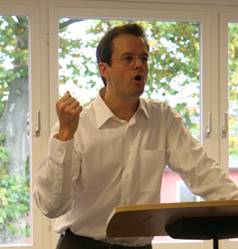
ECLA GUEST LECTURE: Devin Stauffer on Justice and the Structure of "The Republic"
November 16, 2008
Brindusa Birhala (2009, Romania)
Having already adjusted to the academic environment of ECLA, the 2008-09 AY students had the opportunity to accompany their growing familiarity with Plato's Republic with the lecture of Professor Devin Stauffer, a scholar of classical political philosophy. His impetus for reading and discussing Plato comes from his deeply ingrained belief that Platonic works contain "a richer and truer account of human life, of the soul and its deepest concerns, than one can find even in the greatest works of modern philosophy".
The lecture started with a reference to the composition of The Republic, and the possibility of distinguishing "Book One" from the rest of the text, as two different dialogues. "Book One" is concerned with the various definitions of justice, while the rest of the work encompasses the conceptualization of the ideal city. Professor Stauffer quotes Friedrich Schleiermacher for this thesis; together with Friedrich Schlegel, Schleiermacher translated Plato into German at the beginning of the XIXth century. Unfolding upon his observations, Stauffer searches for the philosophical cement holding the two parts together, and finds it in the speeches of Glaucon and Adeimantos at the end of "Book Two". What had happened in the first part was dissatisfying to the expectations of the two men, and culminated with the definition of justice given by Thrasymachus, namely, the advantage of the strong. Thus they urgently demand a more vigorous refutation from Socrates, prompting the entire utopian construct in the second part. Glaucon's speech appears to be the most impressive, requesting a defense of justice as an ultimate goal, and expecting to hear about its inherent value; to render its advantages, he puts into balance the life of the perfectly just man with that of the perfectly unjust.
Stauffer offered the students an insightful view ahead into the dialogue, by questioning the necessity of building an ideal city of justice, and using it as a paradigm for justice in the individual. What this project seems to demand is the interrogation of the nature of justice. Is justice something communal, if it is so tightly dependent on the particular individual who derives the greatest benefits from it? One manner of interpreting The Republic put forward by Prof. Devin Stauffer would be that it represents a complicated thought experiment about the undesirable aspects of a fully rational city. One that casts away some of the manifestations that are most dear to man: poetry, music, private property and family.
Professor Stauffer's research focuses on classical and early modern political thought, as well as the divide between them, with special attention to the origins of liberalism and the foundations of modernity. He is currently a faculty member at the University of Texas, Austin, having previously positions at Kenyon College and St. John's College in Annapolis, Maryland. He is the author of two works on Platonic dialogues: Plato's Introduction to the Question of Justice (SUNY, 2001) and The Unity of Plato's Gorgias: Rhetoric, Justice, and the Philosophic Life (Cambridge, 2006). He has also collaborated in the authorship and translation of Empire and the Ends of Politics: Plato's Menexenus and Pericles' Funeral Oration (Focus Philosophical Library, 1999).
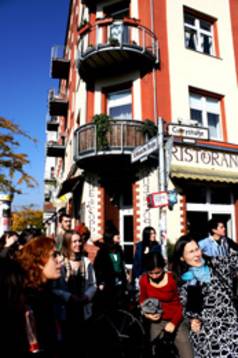
ECLA BERLIN WEEKEND
November 15, 2008
Elena Volkanovska (2009, Macedonia)
October 11th and 12th, better known as 'the Berlin weekend', were the days when the new students eager to explore the heart of Germany had the chance to feel the pulse of a city '…condemned forever to becoming and never being.'
The programme offered something for everyone: we all got the opportunity to peak into those parts of the city which intrigued us most. Professor Geoff Lehman offered a walk to advocates of the esthetic values of architecture in Schöneberg and Charlottenburg. On the other hand, students interested in seeing the other kind of many cultural sides of Berlin were led by art historian Aya Soika through Kreuzberg, a conglomerate of diverse nationalities and a utopia for supporters of the alternative art and lifestyle.
Yet, this was only the morning of October 11th. The lovely weather advanced throughout the whole day and thus largely contributed to the creation of a perfect atmosphere for the Indian summer walk through the Tiergarten Park in the afternoon. Then again, another group of students decided to enjoy the artistic side of Berlin by going on a tour to a gallery in Mitte, where they had a chance to have a look at rather captivating installations by different artists.
Reflections of the day were shared during dinner, when the whole ECLA group was reunited. This served as a starting point for the second part of the day: a group who was eager to absorb as much as possible from Berlin culture had the opportunity to see Prokofiev's opera "Die Drei Orangen" at the Komische Oper, whereas another group went a step further, introducing their own culture by reading poems from their countries at the poetry night held in David Hayes' apartment. The day ended with the welcoming party organised by the students for the students, faculty and administration at Kuckhoff 24.
Sunday, October 12th, started with a relaxing walk in Prenzlauer Berg, regarded as one of the most attractive neighborhoods in Berlin, with cafes, pubs, restaurants and galleries adding to its overall relaxing aura. Another option was to visit the Mauermuseum, one of the museums in Berlin that attracts a vast number of visitors every year, and also to have a look at a traditional Sunday flea market in Mauerpark.
The afternoon was oriented towards 'team-building' activities: the students of ECLA were divided into two groups and rowing on the Dragon Boat, giving the best of them to defeat the opponent. However, it was not victory that mattered; it was the fun and the excitement, since some of us experienced rowing for the first time. Moreover, the sight of the fellow-students dressed in blue and yellow raincoats completed the amusing circumstances in which the Dragon Boat race took place.
Yes, Berlin is the place for the adventure-seekers and the free minded, for those who strive to understand life, to feel change and to discover the unknown. The Berlin weekend was an extensive introduction to what will probably turn into a thorough, year-long exploration of the secrets of one of the most alluring and European metropolis, which built its fame upon the contrasting, yet complementing nature of its parts. As Jean Paul, a famous German writer, said: "Berlin ist mehr ein Weltteil als eine Stadt" ("Berlin is rather a part of the world than a city") (Jean Paul, writer, 1800)
ECLA Selected to Become Model Campus for Liberal Education
Together with 45 U.S. institutions the European College of Liberal Arts will form a Leadership Coalition, committing its campus to becoming a model for what liberal education can offer-and most effectively deliver.
The Coalition is part of the Bringing Theory to Practice Project (BTtoP), an independent project in partnership with the Association of American Colleges and Universities with the generous support of the S. Engelhard Center, the Charles Engelhard Foundation, the Christian A. Johnson Endeavor Foundation, and the Lumina Foundation.
The objective in forming the Coalition is to encourage and support those institutions which are committed to providing successful models of how a campus culture focused on actively engaging students in learning, and evaluating their success in doing so, can address the full dimensions of the intellectual, emotional, and civic flourishing of students.
In addition to receiving grant support, the participating institutions agree to:
- Hold relevant internal conversations regarding the institution's commitment to a call for a "campus culture for learning", what that will mean for their campus, and what strategies they may employ.
- Establish a leadership/planning team that would initiate plans to fit their own institutional culture. The plans they develop will be presented at a national workshop session in 2009.
- Put into practice their plans beginning in calendar year '09. A retrieval and dissemination conference will occur 2010. The campus projects will constitute the examples that will become the central features of a nationally distributed publication, promulgating the institutions as models of successful, effective and affordable "Strategies for Change in Creating and Sustaining Campus Cultures for Learning".
The Leadership Coalition includes renowned American Liberal Arts Colleges such as Bates College, Bennington College, Bryn Mawr College, Franklin and Marshall College, Hampshire College, and Sarah Lawrence College.
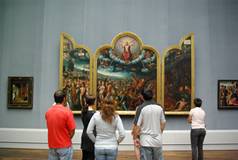
SUNDAY AT THE GEM LDEGALERIE
August 14, 2008
Alin Ivascu (ISU 2008, Romania)
Sunday 3 August 2008: the most beautiful weather in Berlin and ECLA students just can't get enough food for thought. Art historian Aya Soika gave ISU 2008 students a tour of the Gemäldegalerie focusing on the week's themes: religion, violence, martyrdom.
Situated in the Kulturforum, west of Potsdamer Platz, the Gemäldegalerie hosts two kilometers of masterpieces from the likes of Dürer, Giotto, Rubens, Botticelli, van Eyck, Bruegel, Raphael, Tizian, Caravaggio, or Rembrandt. With close to 1500 works, the gallery takes its visitors on a journey spanning five centuries (from the 13th to the 18th) and most of Western Europe, a journey on which ISU students gladly embarked.
A visual analysis crash course took students through religious paintings from the 13th to the 17th century. Elements of technique, size, space, color and content stirred students' curiosity and led to interesting debates both inside and outside themuseum. The group was asked to reflect on and compare the depictions of Saint Sebastian by Botticelli and Rubens or to interpret Giotto's "The Burial of Mary". Students of law, business, political science, history or philosophy - all touched by Aya's Socratic, ad-hoc lectures - became amateur art historians contextualizing, criticizing and pondering on the artworks proposed for discussion.
This event was the fourth in the "Culture Crawl" organized by ECLA for the ISU 2008 students and followed others such as a revealing tour of Berlin, an intriguing visit to the Deutsches Historisches Museum and a relaxing Potsdam trip. After challenging lectures, seminars and screenings, one would assume that students would take advantage of the sunny day and roam the streets of the German capital. Yet, long after the tour was over, some could still be seen closely examining the great paintings of the Gemäldegalerie; without a doubt, a secondary effect of the ECLA condition, a contagious disease that manifests itself mainly through an unquenchable thirst for knowledge and spontaneous outbursts of enlightened commentary.

